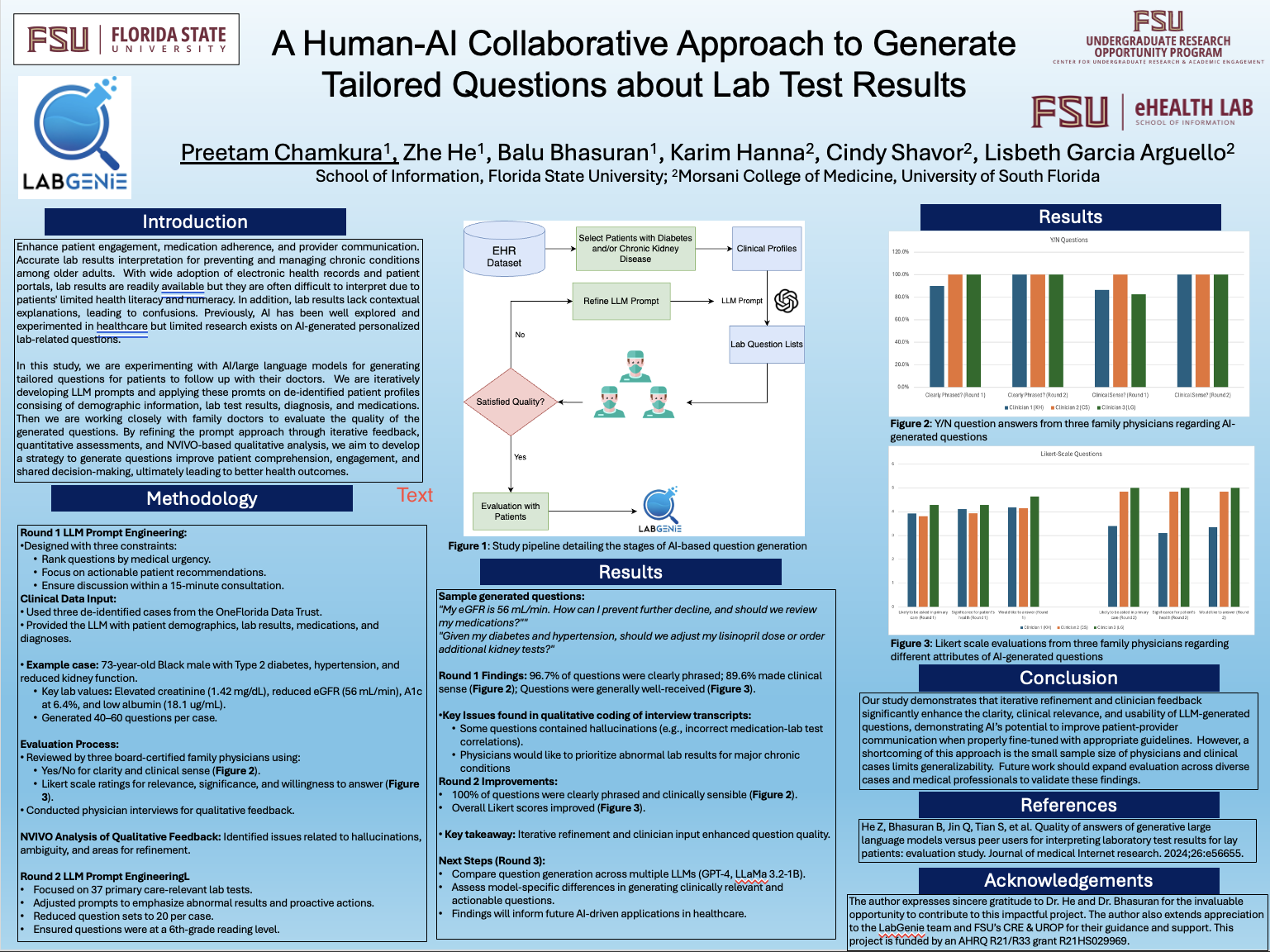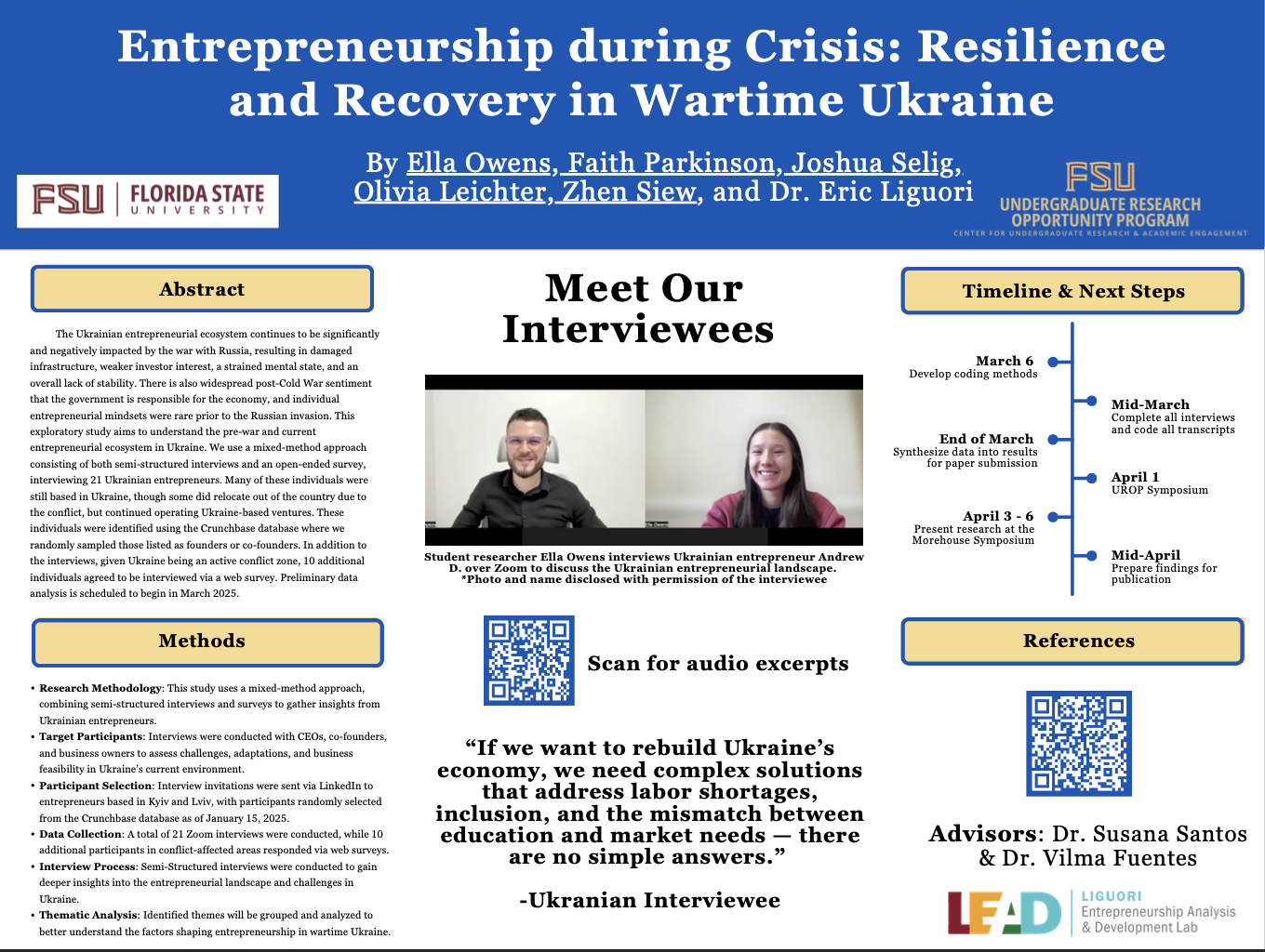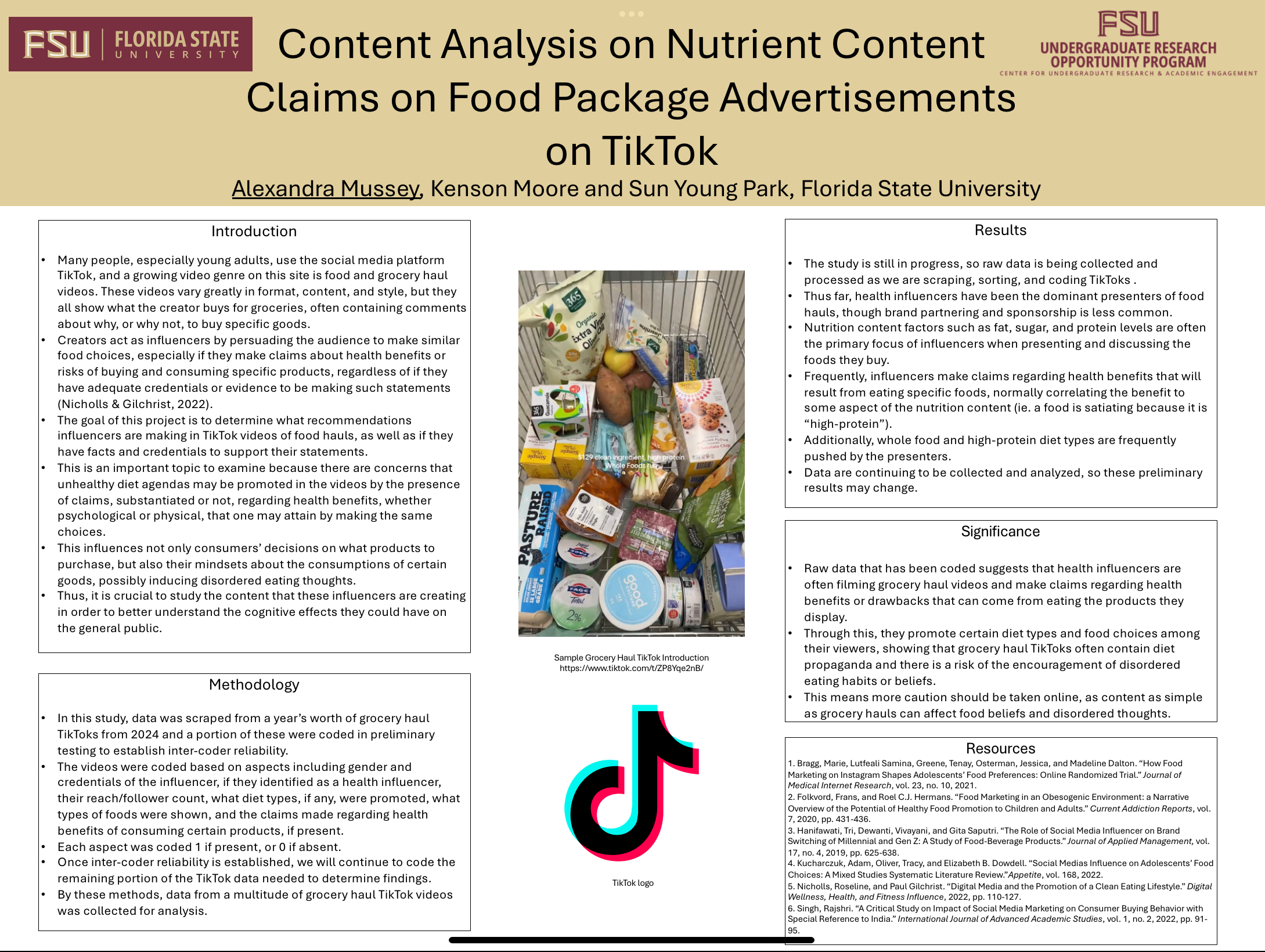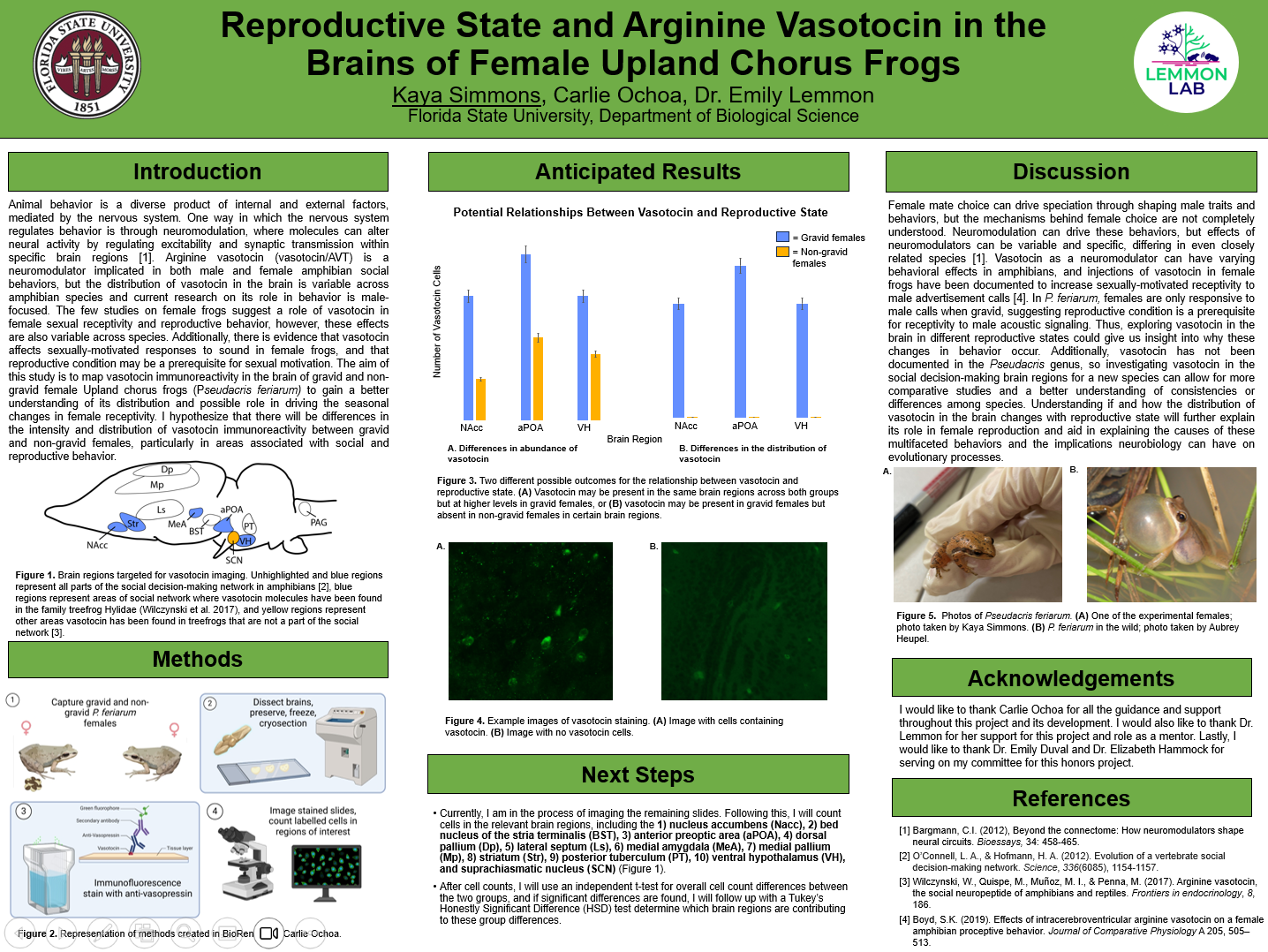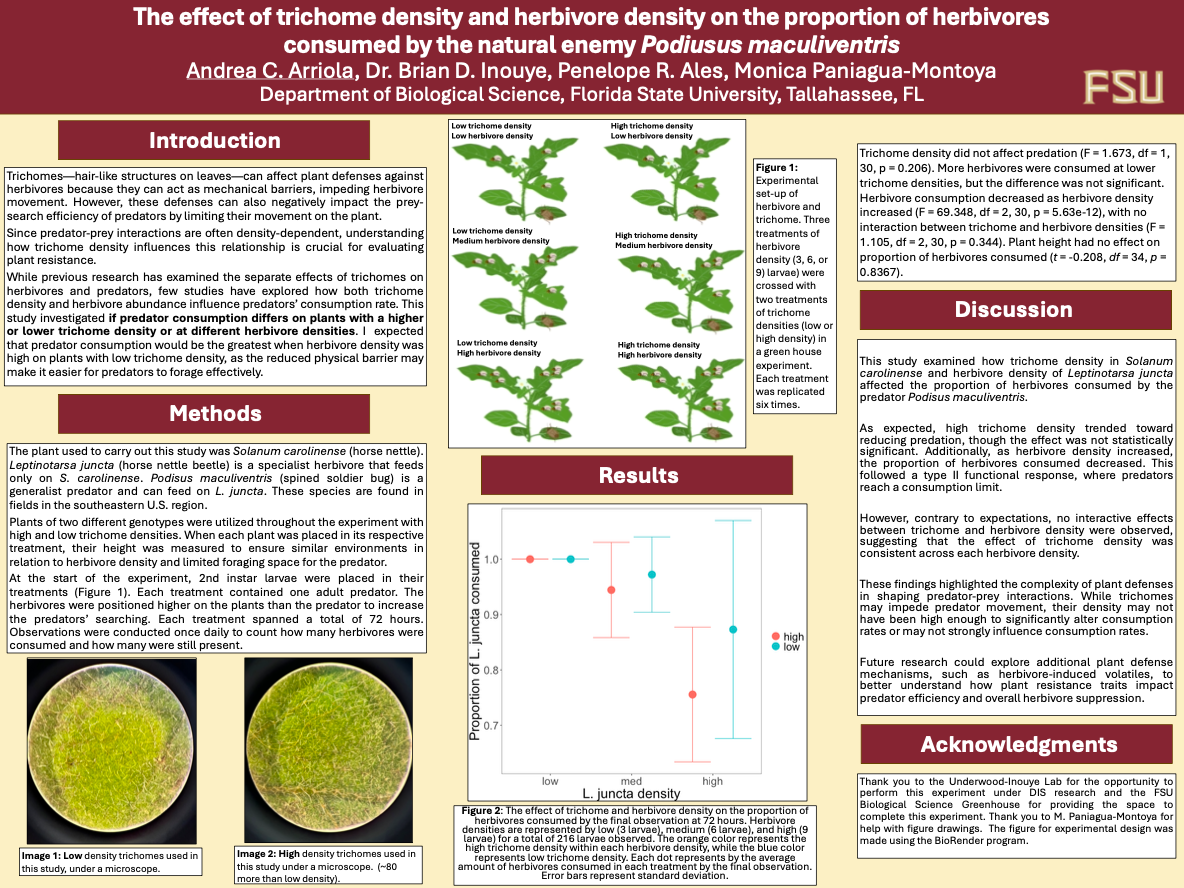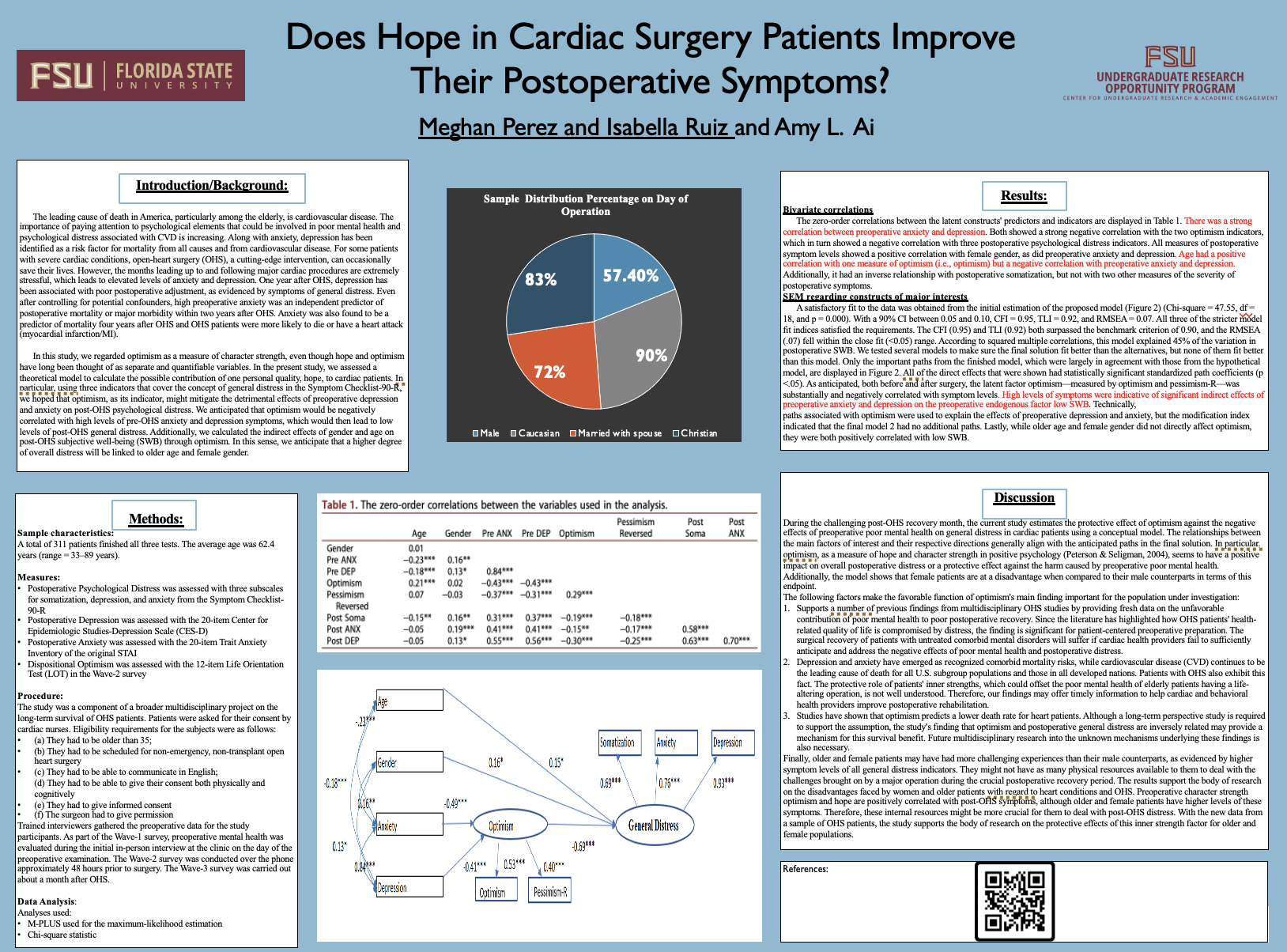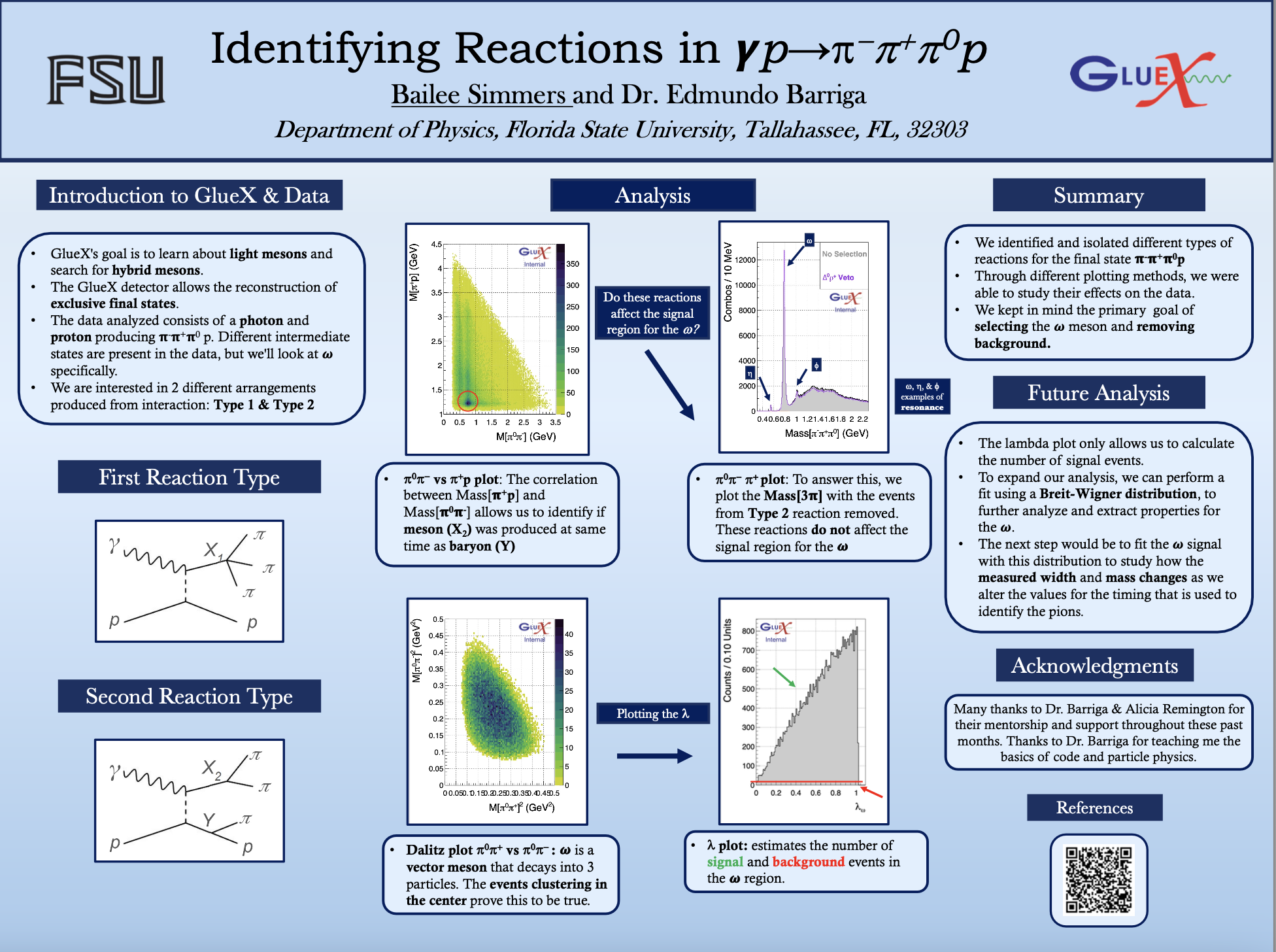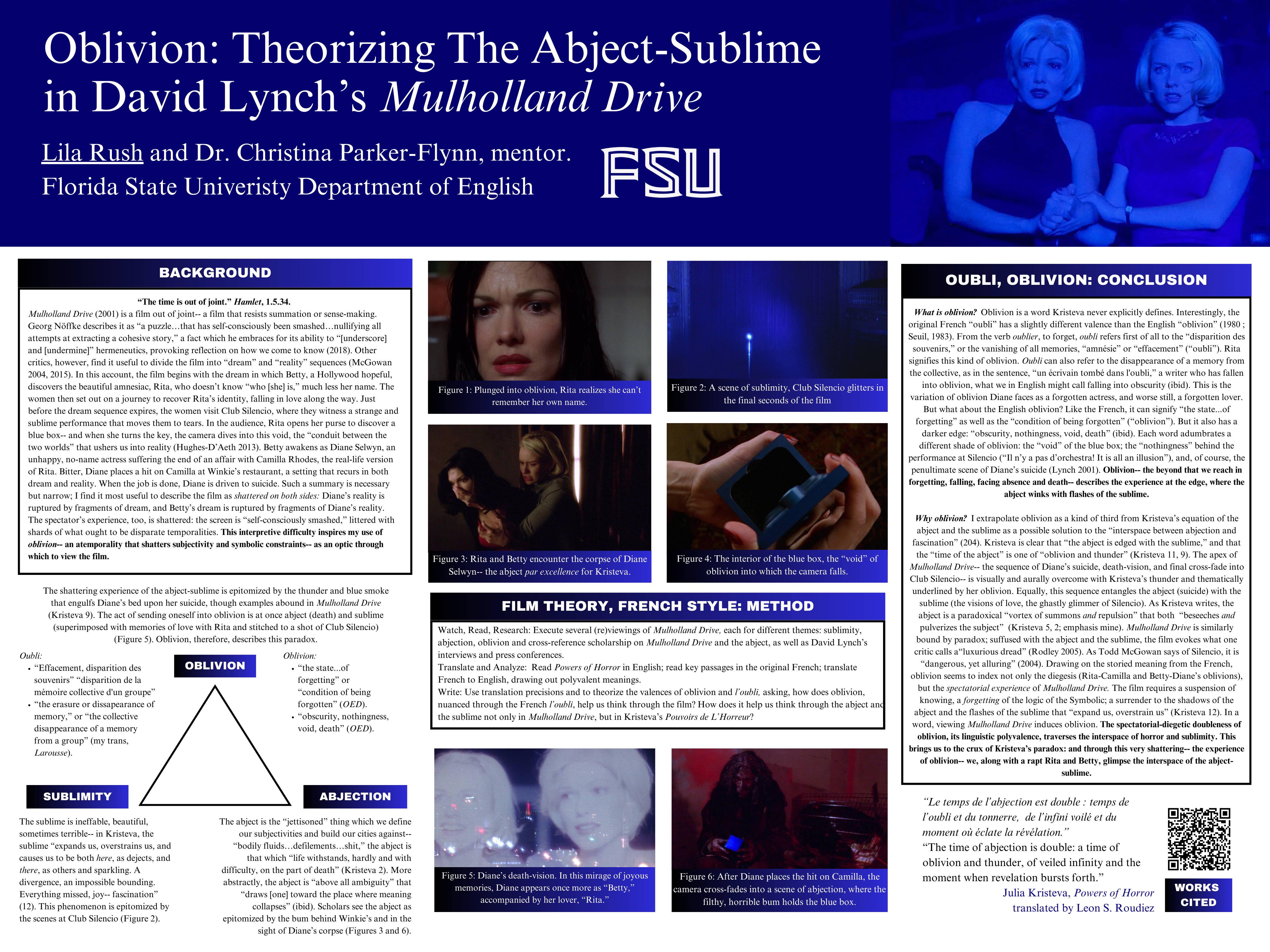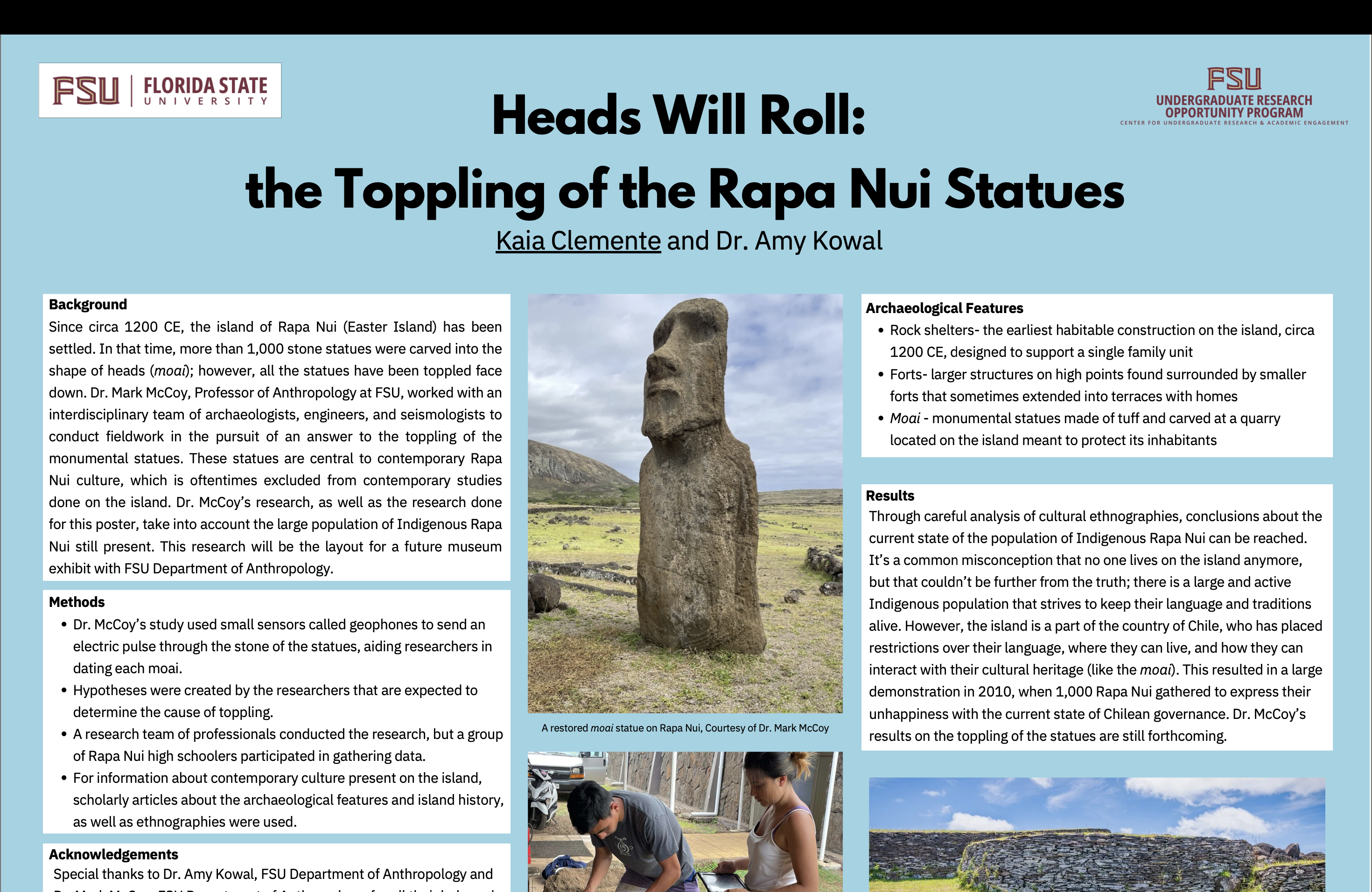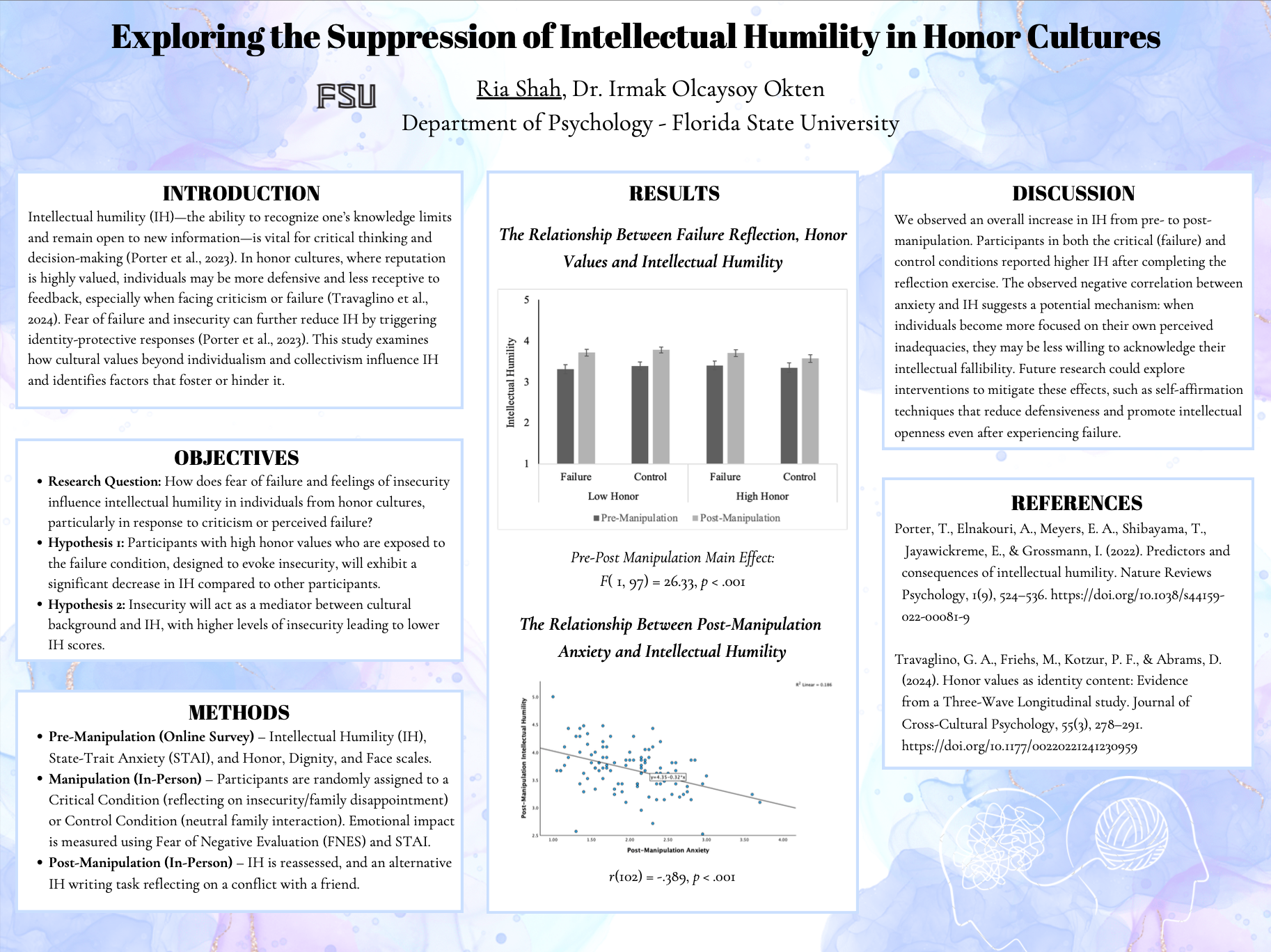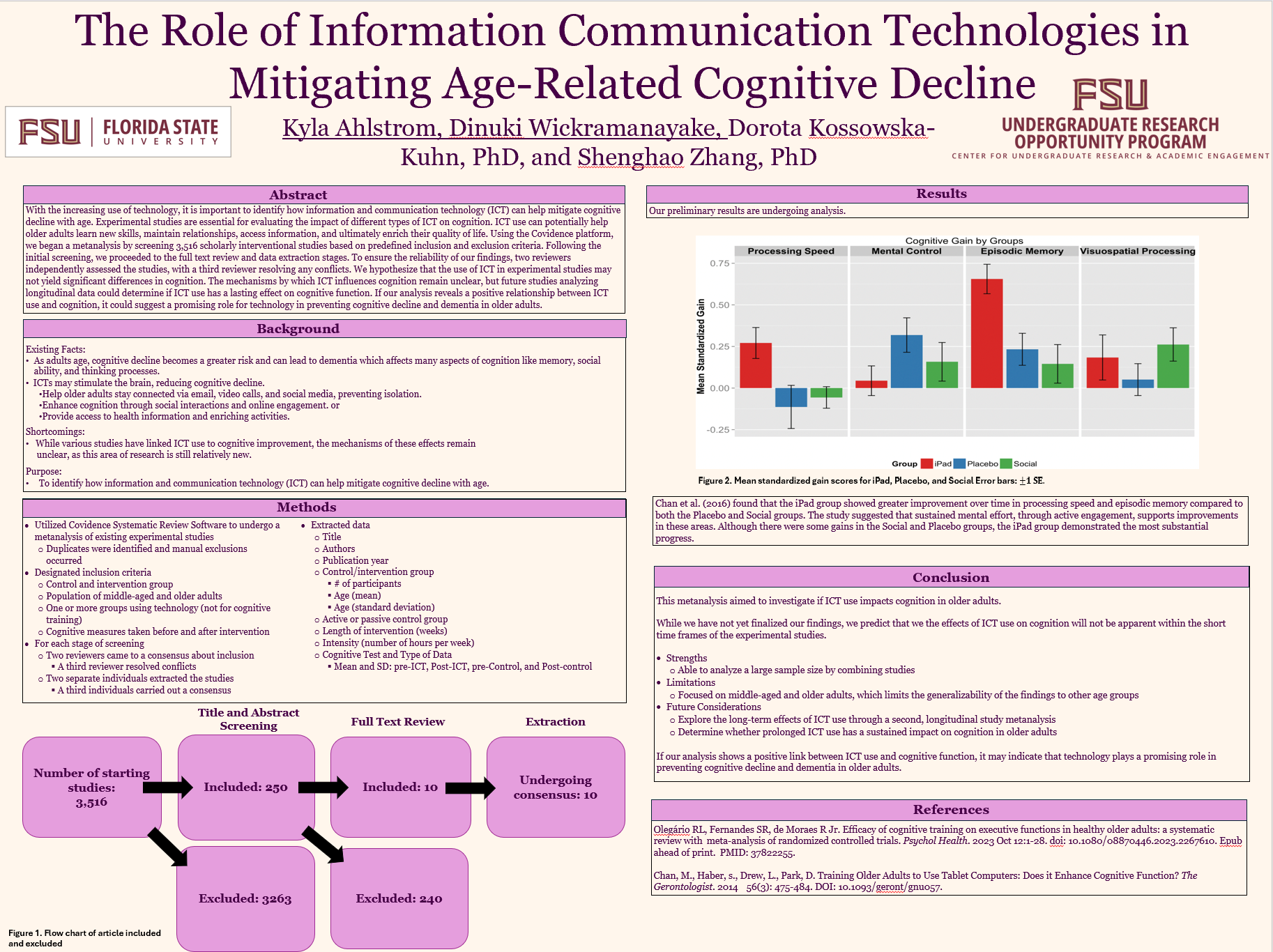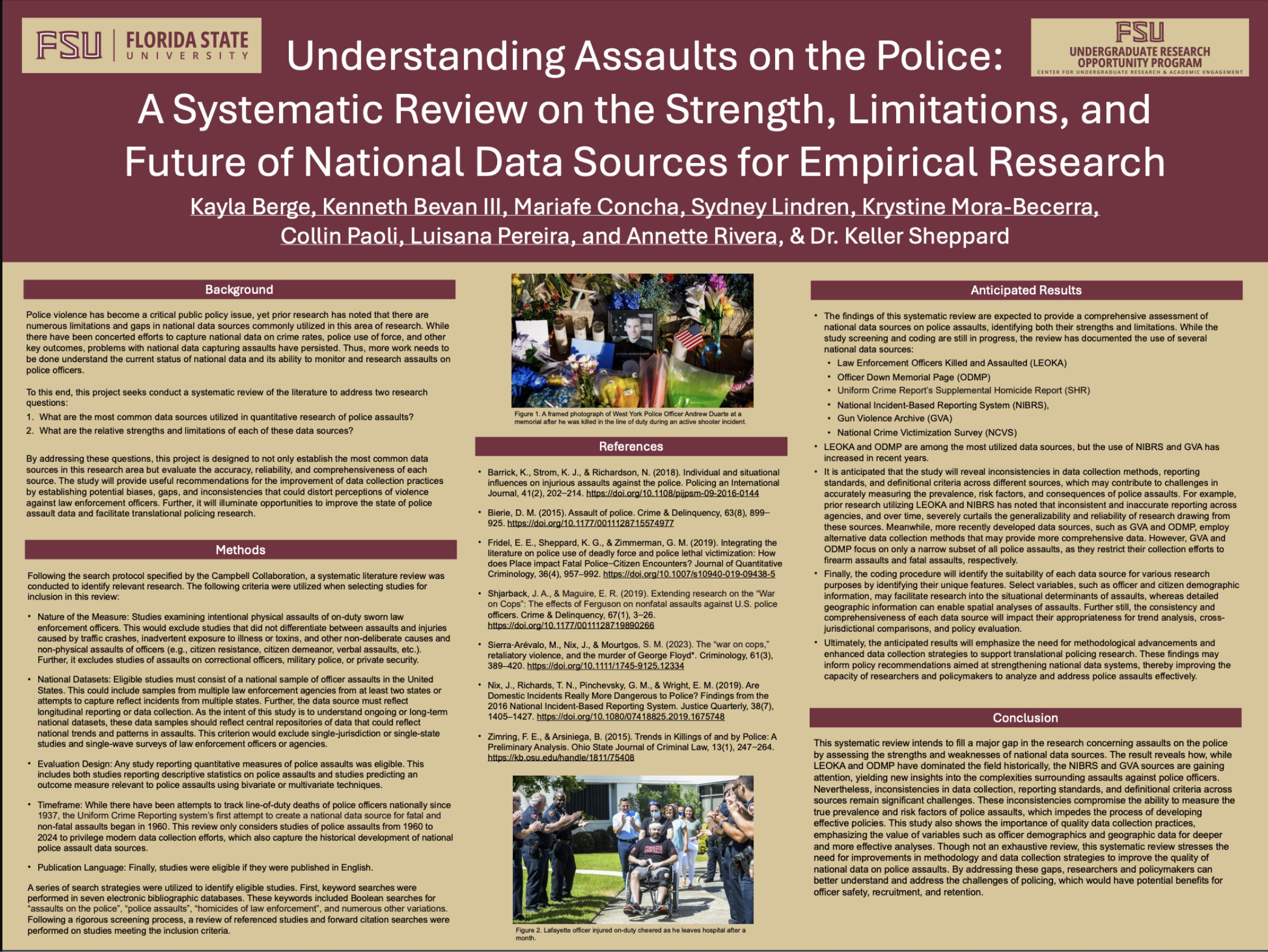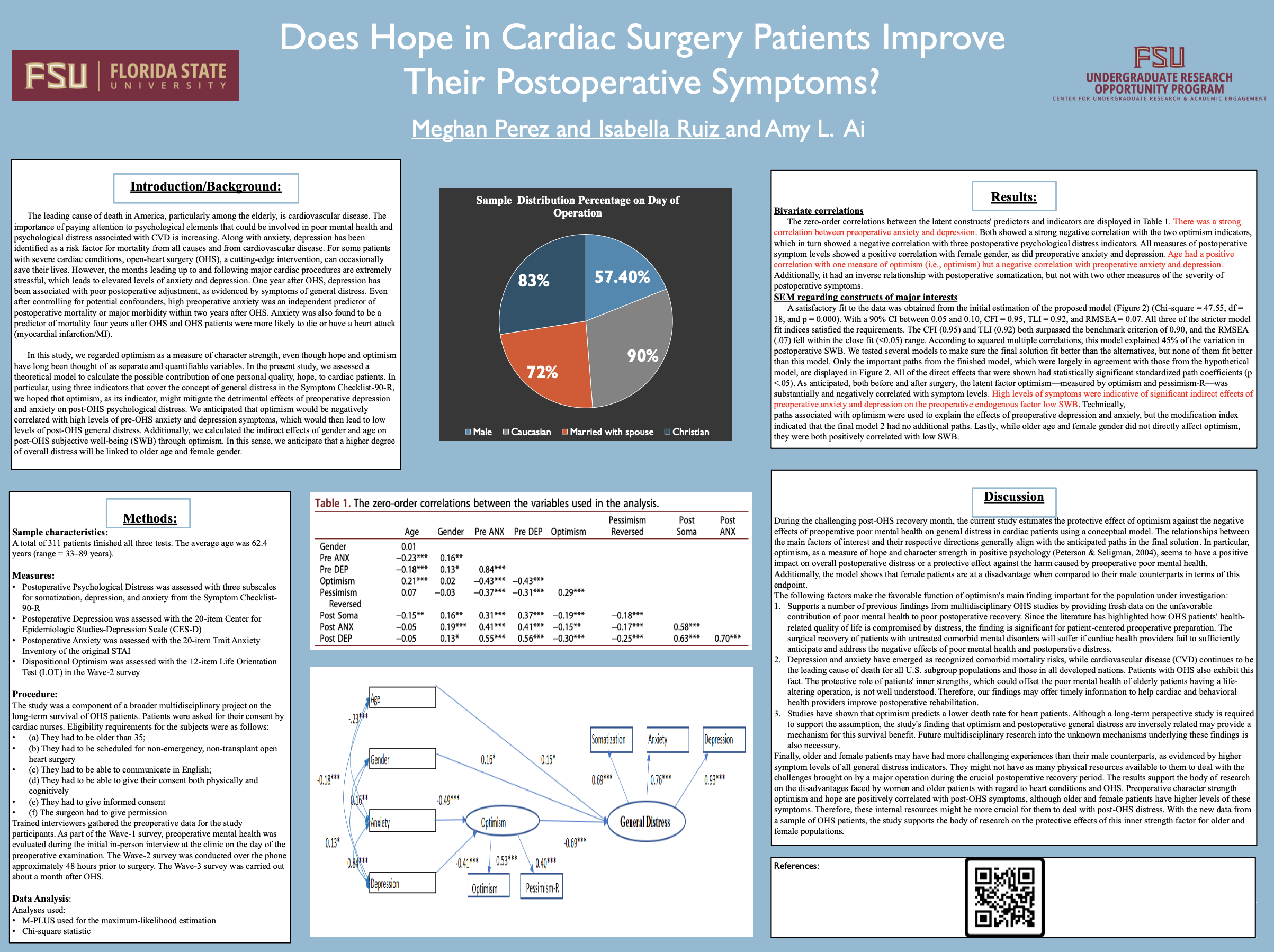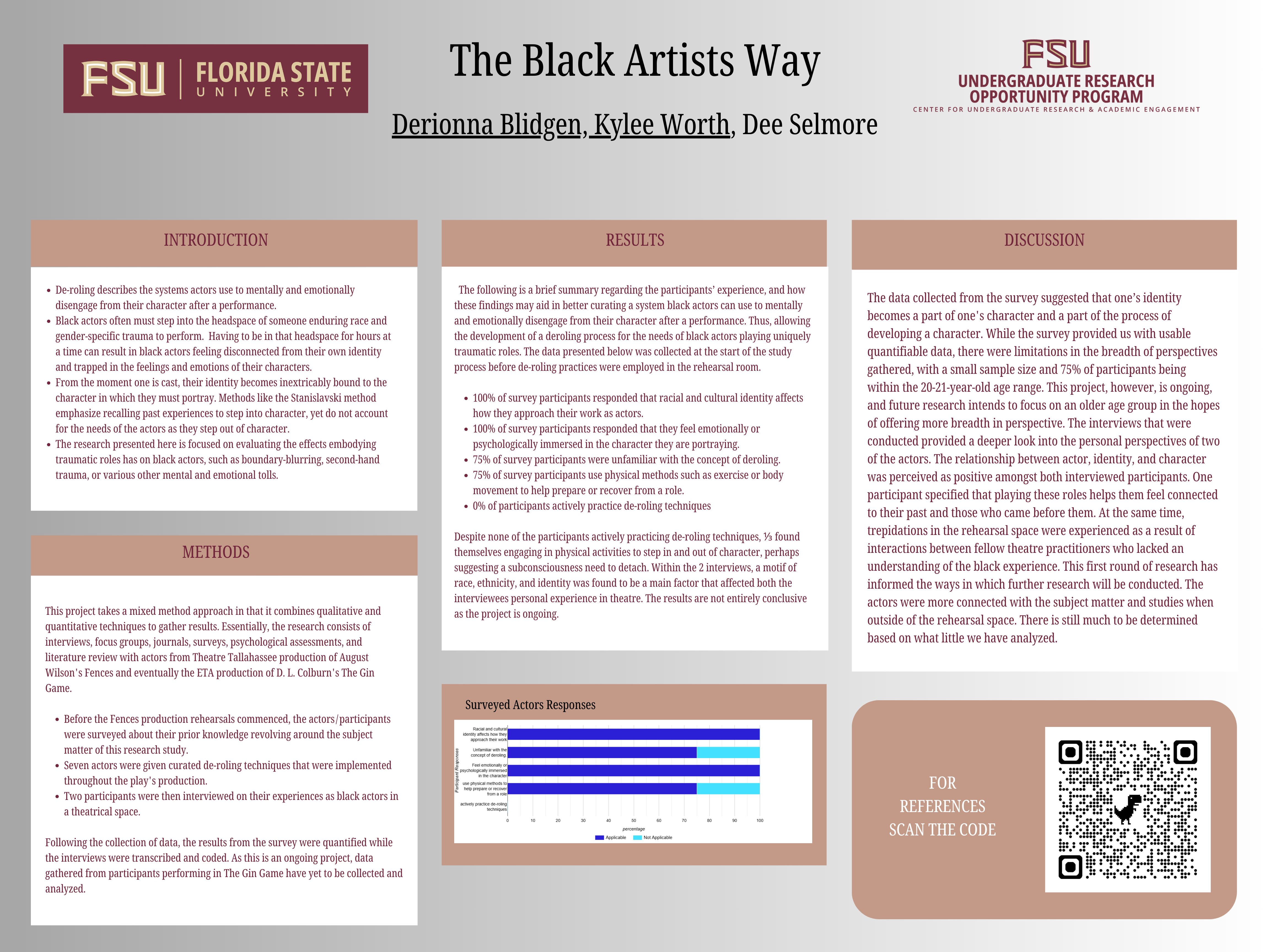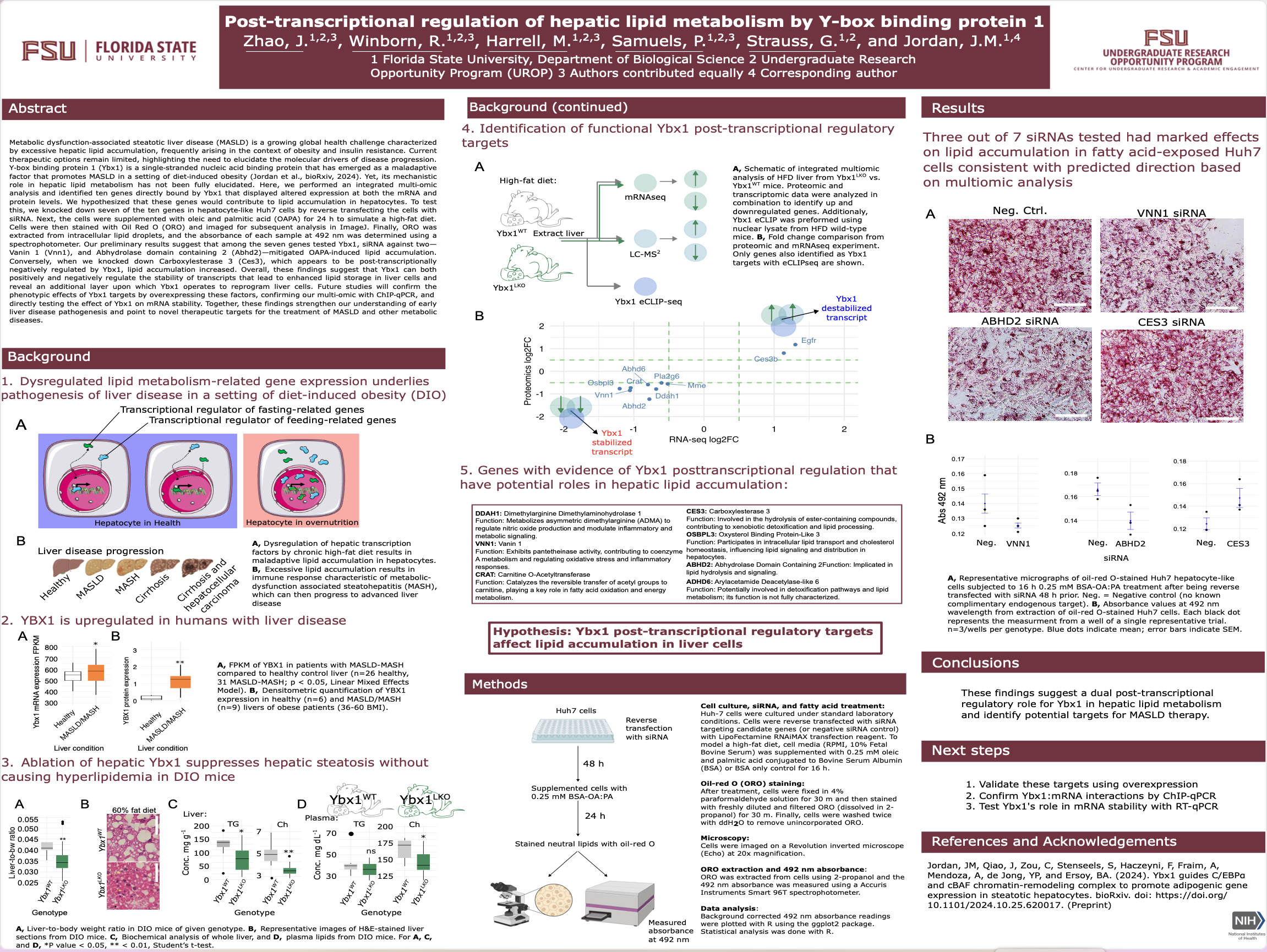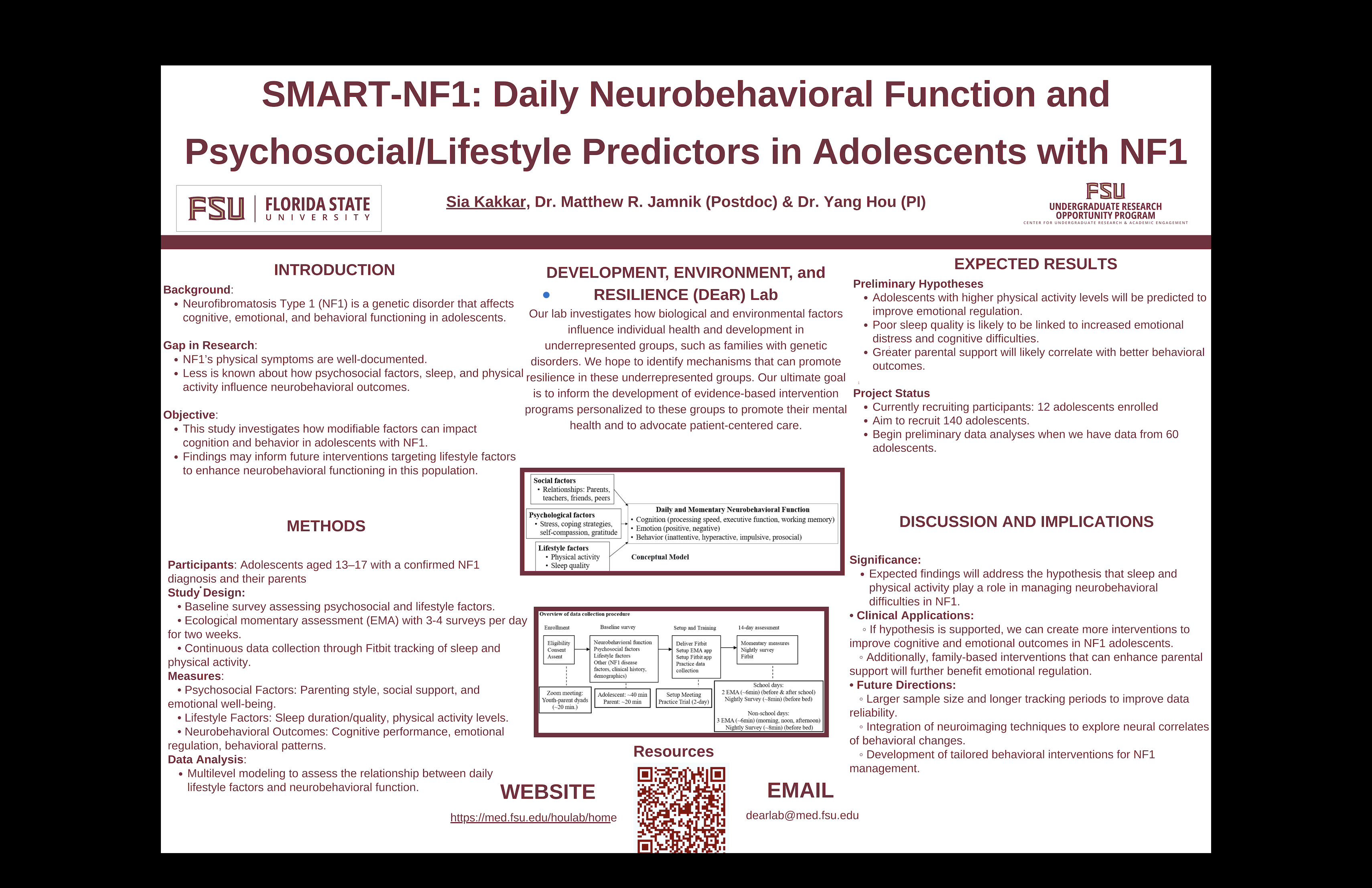Research Symposium
25th annual Undergraduate Research Symposium, April 1, 2025
Preetam Chamkura Poster Session 1: 9:30 am - 10:30 am/ Poster #202

BIO
My name is Preetam Chamkura, and I'm a second-year Computer Science student here at FSU. I am interested in AI and how to use it to solve real-world issues. My career interests include machine learning, data analysis, and cybersecurity and how they can impact fields in the real world.
A Human-AI Collaborative Approach to Generate Tailored Questions about Lab Test Results
Authors: Preetam Chamkura, Dr. Zhe HeStudent Major: Computer Science
Mentor: Dr. Zhe He
Mentor's Department: School of Information Mentor's College: College of Communication and Information Co-Presenters:
Abstract
Patient portals can improve patient engagement and healthcare outcomes, especially for older adults with chronic conditions. However, limited health literacy and technology skills hinder their ability to interpret lab results effectively. This research aims to develop LabGenie, a web-based tool designed to enhance older adults’ comprehension of lab results.
We have been evaluating the feasibility of using generative large language models to generate lab results-related questions from patients' electronic health records. After we used GPT 4.0 to generate 40-60 questions for each of the three selected patients with diabetes and chronic kidney disease, we interviewed three physicians to gather insights into lab test selection, clinical relevance, and AI-driven question generation. Thematic analysis of the transcripts revealed five key themes: project planning and progress, data and lab tests, AI and technology, collaboration and feedback, and research considerations. These themes informed the iterative design of LabGenie’s AI-powered question generation module.
Preliminary findings suggest that focusing on standardized and symptom-driven lab test selection, while tailoring question prompts to individual patient needs, can improve usability and engagement. Physicians emphasized the importance of aligning lab test selection with older adults’ common conditions, such as diabetes and hypertension, and ensuring AI-generated questions are clinically relevant and actionable.
This study demonstrates the value of integrating clinician feedback and user-centered methodologies in digital health tool development. LabGenie has the potential to improve accessibility, patient engagement, and shared decision-making, ultimately enhancing health outcomes for older adults.
Keywords: AI, Health Literacy, Lab Result Interpretation, LLM, Healthcare
25th annual Undergraduate Research Symposium, April 1, 2025
Zhen Siew Poster Session 4: 3:00 pm - 4:00 pm/ Poster #84
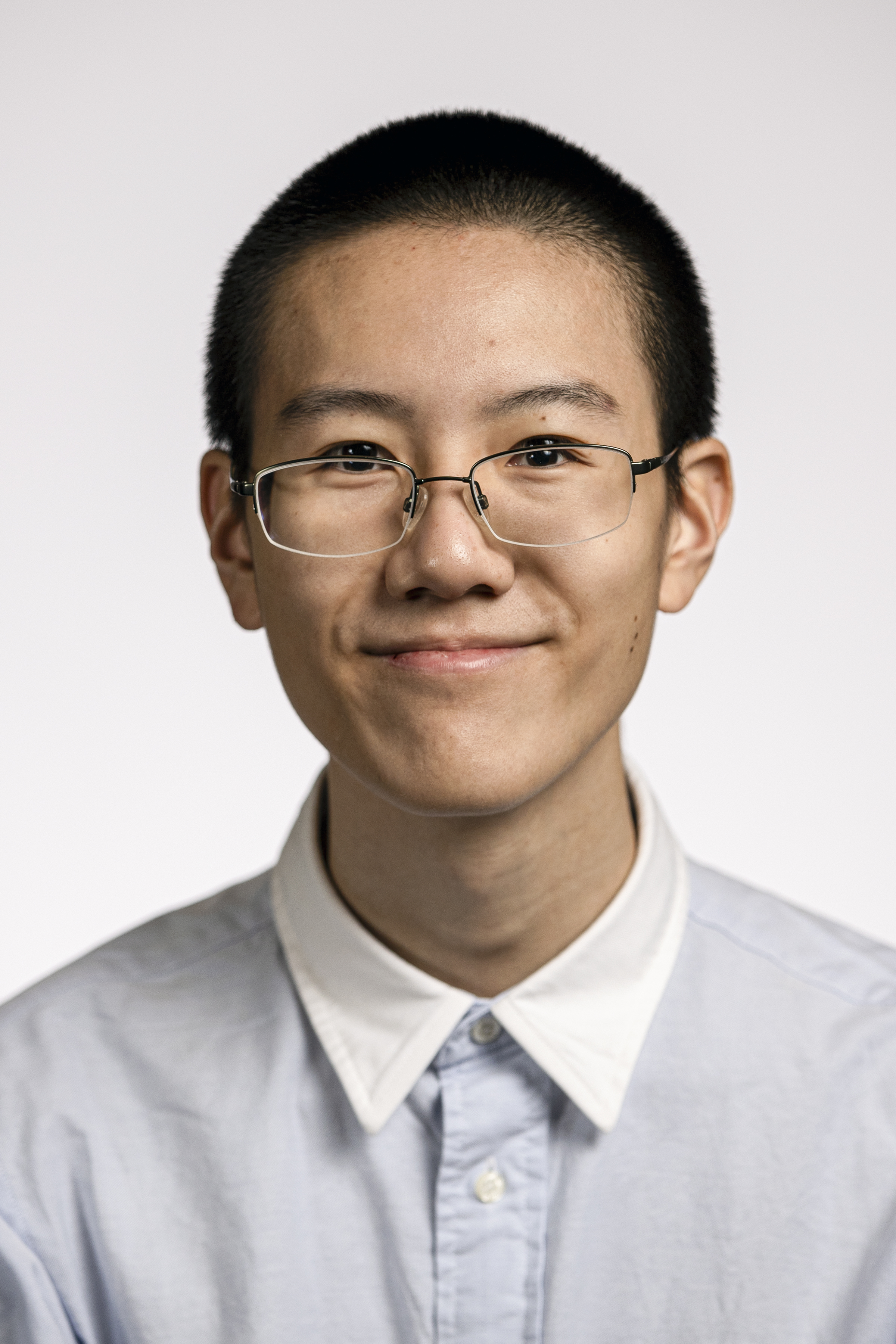
BIO
Born and raised in New York City, Queens. I enjoy playing piano and watching anime.
Entrepreneurship during Crisis: Resilience and Recovery in Wartime Ukraine
Authors: Zhen Siew, Dr Eric LiguoriStudent Major: Management Information System
Mentor: Dr Eric Liguori
Mentor's Department: Research Mentor's College: College of Entrepreneurship Co-Presenters: Ella Owens, Faith Parkinson, Joshua Selig, Olivia Leichter
Abstract
The Ukrainian entrepreneurial ecosystem continues to be significantly and negatively impacted by the war with Russia, resulting in damaged infrastructure, weaker investor interest, a strained mental state, and an overall lack of stability. There is also widespread post-Cold War sentiment that the government is responsible for the economy, and individual entrepreneurial mindsets were rare prior to the Russian invasion. This exploratory study aims to understand the pre-war and current entrepreneurial ecosystem in Ukraine. We use a mixed-method approach consisting of both semi-structured interviews and an open-ended survey, interviewing 15 Ukrainian entrepreneurs. Many of these individuals were still based in Ukraine, though some did relocate out of the country due to the conflict, but continued operating Ukraine-based ventures. These individuals were identified using the Crunch-base database where we randomly sampled those listed as founders or co-founders. In addition to the interviews, given Ukraine being an active conflict zone, 8 additional individuals agreed to be interviewed via a web survey. Preliminary data analysis is scheduled to begin in March 2025.
Keywords: Ukraine, Entrepreneurship, Wartime
25th annual Undergraduate Research Symposium, April 1, 2025
Grace Medure Poster Session 3: 1:45 pm - 2:45 pm/ Poster #99

BIO
My name is Grace Medure, and I am from Jacksonville, Florida. I am an honors student at Florida State University, majoring in Interdisciplinary Medical Sciences with a focus on pre-clinical professions. I am passionate about research, particularly how environmental stressors like temperature and hypoxia affect marine species' performance and survival in regard to climate change. My top career interests are in dermatology and reconstructive plastic surgery, and I plan to attend either medical school or PA school after graduation. In addition to research, I am actively involved in Alpha Epsilon Delta, Kappa Delta, the Honors Student Association, and various service organizations, where I engage in leadership roles and volunteer work. I also volunteer regularly at a hospice center, which has strengthened my ability to provide compassionate care and reinforced my passion for medicine. My dedication to academic excellence and community service reflects my drive to make a meaningful impact in both medicine and society.
Measuring Atlantic Stingray (Hypanus Sabinus) Thermal Performance Using Metabolic and CTmax Studies
Authors: Grace Medure, Alyssa AndresStudent Major: IMS: Pre-clinical Professions
Mentor: Alyssa Andres
Mentor's Department: FSU Coastal and Marine Laboratory Mentor's College: College of Arts and Sciences Co-Presenters: Cole Beiner
Abstract
The Atlantic Stingray is a coastal benthic elasmobranch species found in estuarine and marine habitats, where it experiences seasonal temperature changes. Understanding how these species respond to warming ocean conditions is crucial for predicting future shifts in their movement, habitat use, and physiological limits. Our research focuses on the metabolic and energetic impacts that rising ocean temperatures will have on Atlantic Stingray (Hypanus sabinus). Studying this will help biologists project fishes’ responses to rising ocean temperatures and shifts in viable habitats in reference to climate change. Using respirometry to directly measure fish oxygen consumption and Critical Thermal Maximum (CTmax) trials across starting temperatures of acclimation, this research used metabolic and behavioral challenges to identify temperature sensitivity and thermal limits of Atlantic Stingrays, known to influence fish behavior and viable habitat. We found that CTmax is sensitive to the temperature of acclimation; the rays typically reached a point of disorientation at 37.8 and 38.6 degrees Celsius and a critical thermal maximum of 38.5 and 39.5 degrees Celsius when acclimated to water at 30 & 34 degrees Celsius. We additionally found that all metabolic rates increase with temperature with different levels of temperature sensitivity leading to changes in aerobic scope as temperatures rise. Additionally, our experimental observations found that while the Atlantic Stingray may be tolerant of high temperatures, rising average temperatures and the increasing presence of marine heatwaves may lead to changes in population energy budgets, movement, viable habitat, and habitat use.
Keywords: CTmax, Respirometry, Stringray
25th annual Undergraduate Research Symposium, April 1, 2025
Alexandra Mussey Poster Session 4: 3:00 pm - 4:00 pm / Poster #215
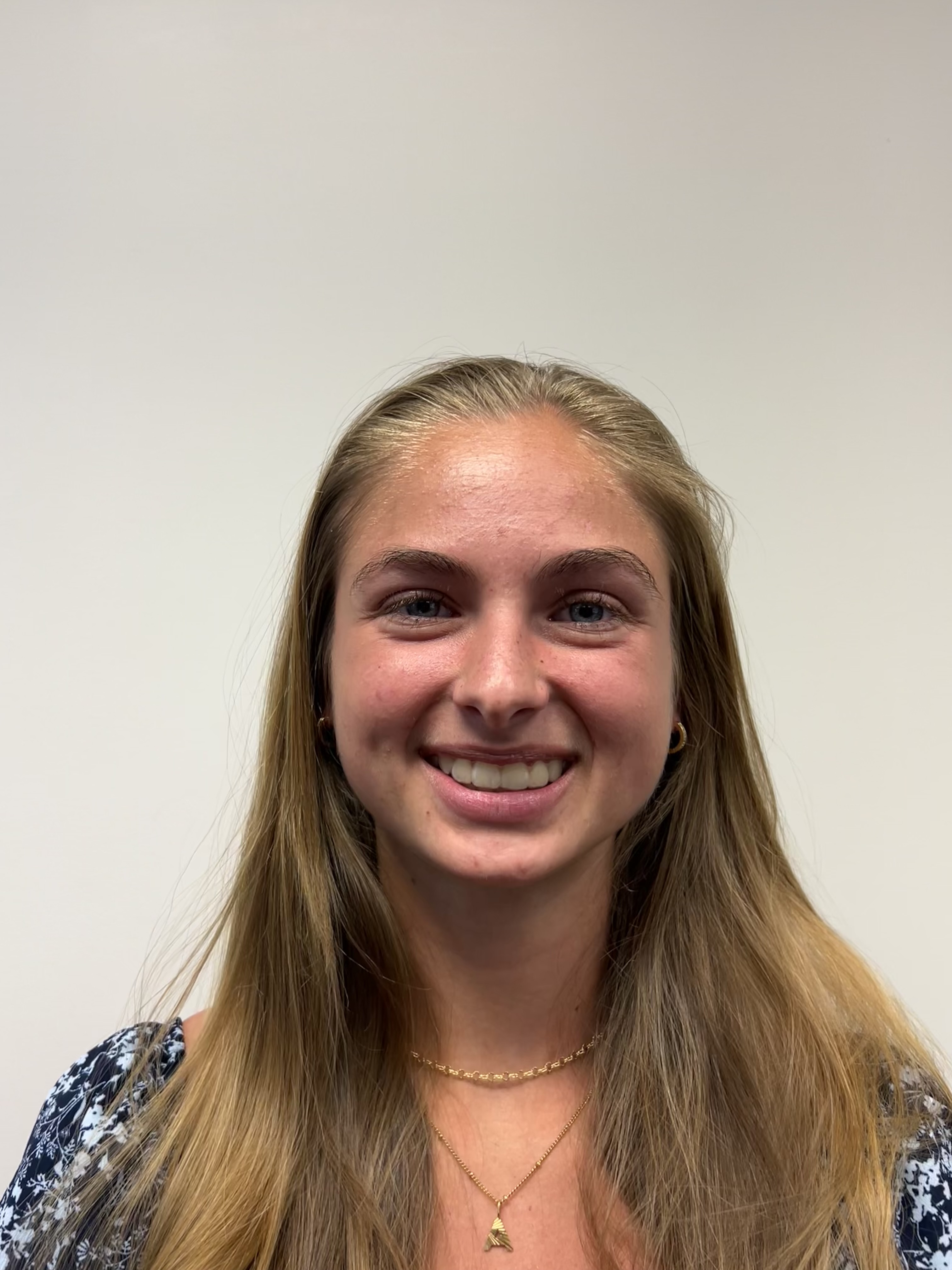
BIO
I am a Freshman at FSU majoring in Biology on a Pre-Medical track. I am interested in performing research on health and diet, especially on disordered eating, and I plan to attend medical school to become a surgeon.
Content Analysis on Nutrient Content Claims on Food Package Advertisements on TikTok
Authors: Alexandra Mussey, Sun Young ParkStudent Major: Biological sciences
Mentor: Sun Young Park
Mentor's Department: School of Communication Mentor's College: Florida State University Co-Presenters:
Abstract
This study determines how recommendations from influencers in TikTok grocery haul videos change consumer food choices. There are concerns that these influencers promote diet agendas by making claims, substantiated or not, regarding health benefits that one may attain via the same choices. This alters consumers’ decisions on what products to purchase, and their mindsets about consuming certain goods, possibly inducing disordered eating thoughts. A quantitative content analysis of TikTok grocery hauls posted from January 2024 to December 2024 will be conducted on influencers who post such videos. Data collected from these TikToks was coded in preliminary testing for inter-coder reliability. The videos were coded on gender of the influencer, diet types promoted, types of foods shown, claims made regarding health benefits of certain products, and more. Once inter-coder reliability is established, coding will continue for the remaining TikTok data. The study is ongoing, but raw data is being collected and processed. Thus far, health influencers have been the dominant presenters of food hauls, and nutritional content factors regarding fat, sugar, and protein are their primary focus. Additionally, they frequently endorse whole food and high-protein diet types. The coded raw data suggests that health influencers are often filming grocery haul videos and commonly make claims regarding health benefits or drawbacks that can come from eating the products they display, promoting certain diet choices among their viewers. Thus, grocery haul TikToks often contain diet propaganda, and there is a risk of the encouragement of disordered eating habits or beliefs.
Keywords: Nutrition, Social media, Food advertisement
25th annual Undergraduate Research Symposium, April 1, 2025
Kaya Simmons Poster Session 4: 3:00 pm - 4:00 pm/ Poster #118
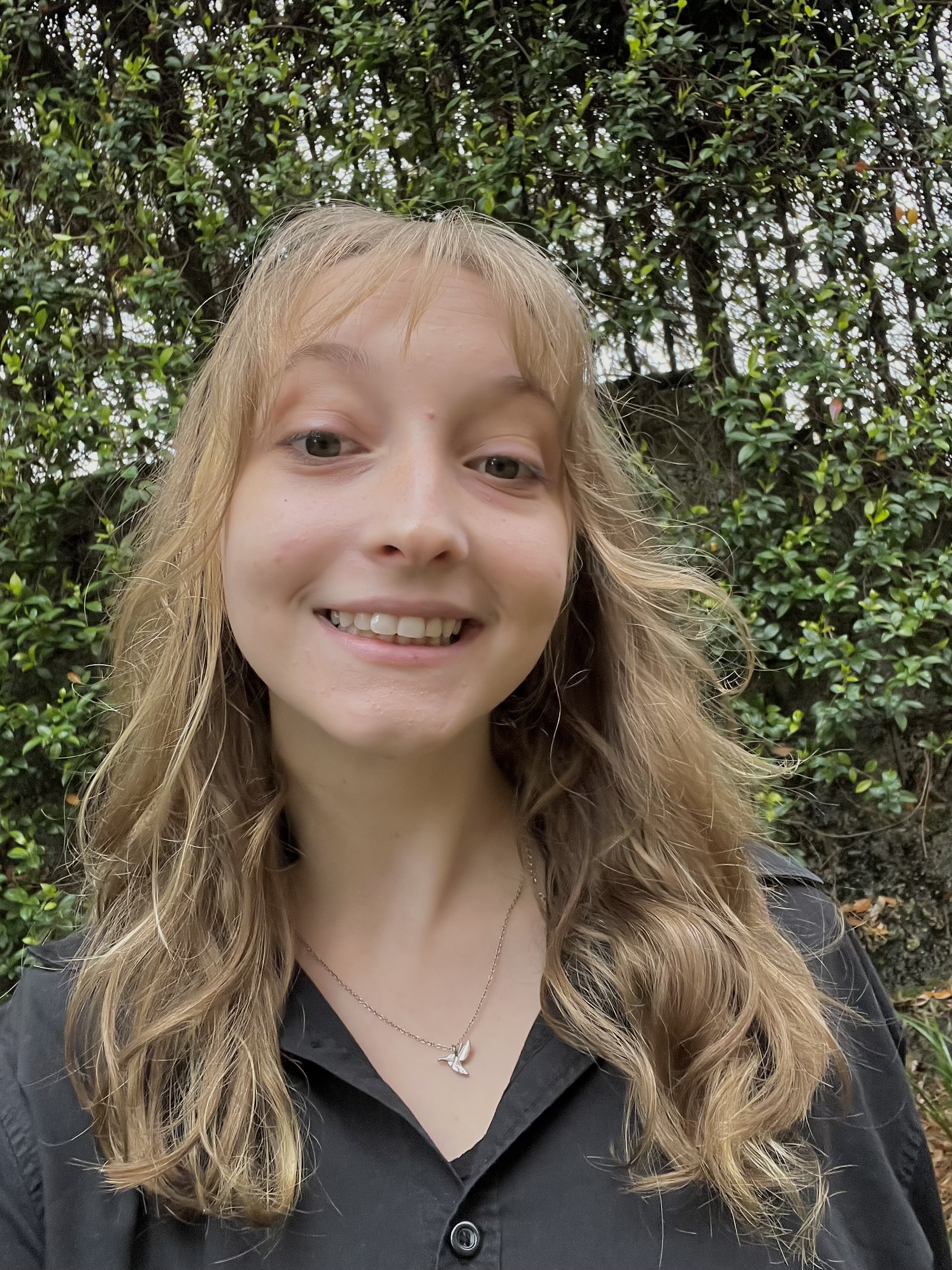
BIO
I am a third-year neuroscience major interested in non-human behavioral biology, behavioral ecology, and neuroethology. I have been conducting research since my first semester at FSU, and plan to continue doing so for the rest of my time as an undergraduate. Outside of this project and my work in the Lemmon lab, I work in the DuVal lab investigating complex cooperative mating behavior in a tropical bird, as well as lead a project sampling fatal bird-window strikes on the FSU campus. Once I graduate, I plan to complete a PhD and pursue research in animal behavior full-time.
The relationship between reproductive state and arginine vasotocin in the brains of female Upland chorus frogs (Pseudacris feriarum)
Authors: Kaya Simmons, Dr. Emily LemmonStudent Major: Behavioral Neuroscience
Mentor: Dr. Emily Lemmon
Mentor's Department: Biological Sciences Mentor's College: Florida State University Co-Presenters:
Abstract
Neuromodulation, the process by which signaling molecules alter neuronal activity, can regulate behavior by changing neural or physiological responses. Vasotocin is hormone that can act as neuromodulator and is highly implicated in both male and female amphibian social behaviors. The physical distribution of vasotocin in the brain is highly variable across amphibian species. Current research on the role of vasotocin in behavior is largely focused on males. However, studies on female frogs across genera suggest a strong role of vasotocin in female proceptivity and reproductive behavior. Specifically, vasotocin affects female proceptivity to male acoustic signals, which is a prerequisite for sexual motivation during female mate choice. The aim of this study is to map vasotocin immunoreactivity in the brains of gravid and non-gravid female Chorus frogs (Pseudacris feriarum) to gain a better understanding of its distribution and possible role in driving the seasonal changes in female receptivity. We extracted brains from 12 wild-caught frogs, including 6 females in reproduction condition (with eggs) and 6 females in non-reproductive condition (without eggs) and used immunofluorescent staining to identify vasotocin distribution in target brain regions related to social behavior. We hypothesize there will be differences in the distributions of vasotocin between gravid and non-gravid females, particularly in areas associated with female reproductive behavior. This research will not only contribute to the body of work describing variation in the neuroanatomical distribution of this nonapeptide, but also reveal the more about the neural mechanisms that drive female social and reproductive behavior.
Keywords: Neurobiology, neuromodulation, reproductive behavior, immunohistochemistry
25th annual Undergraduate Research Symposium, April 1, 2025
Andrea Arriola Poster Session 4: 3:00 pm - 4:00 pm/ Poster #280
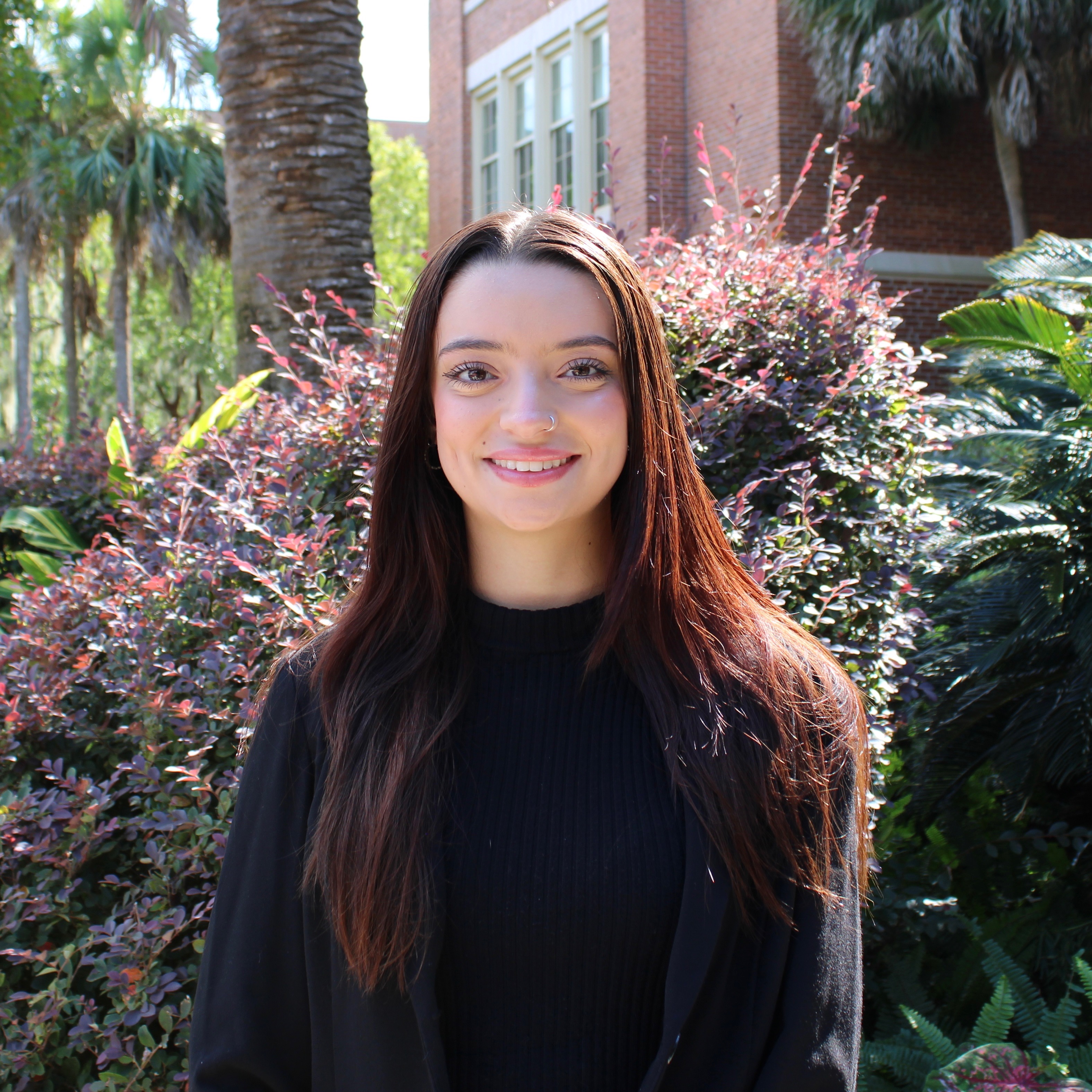
BIO
Hi! My name is Andrea Arriola. My hometown is Miami, Florida. My family is from Nicaragua and Argentina. I am a senior majoring in Biological Science, minoring in Chemistry and Public Administration. I am on the pre-dental track and I will be applying to dental school this summer to fulfill my dream of becoming an oral health doctor. My research focuses on the ecological interactions between plant defenses, herbivores, and predators. My appreciation for nature and the interconnectedness of the world around me has driven my interest in understanding the roles organisms play within ecological systems, making this research both intriguing and meaningful.
The effect of trichome density and herbivore density on the proportion of herbivores consumed by the natural enemy Podiusus maculiventris
Authors: Andrea Arriola, Dr. Brian D. InouyeStudent Major: Biological Science
Mentor: Dr. Brian D. Inouye
Mentor's Department: Department of Biological Science Mentor's College: College of Arts & Sciences Co-Presenters:
Abstract
Non-glandular trichomes, a hair-like structure on plants that can be used for defense against herbivores, can also impede predator movement and search efficiency, leading to lower predation rates on herbivores. Prey can be more accessible to predators in plants that have lower trichome densities. Because little is known on how both trichome density and herbivore density can affect the feeding behaviors on predators, their effects were investigated by using Solanum carolinense, containing stellate non-glandular trichomes, and its specialist herbivore, Leptinotarsa juncta, with the predator Podisus maculiventris. A greenhouse mesocosm experiment utilized a factorial design, using low and high trichome densities with varying herbivore densities (3, 6, 9 larvae) over 72 hours to measure the proportion of herbivore consumption by predators. There was no significant difference in the proportion of herbivores consumed between high and low trichome densities, although more herbivores were consumed in the low trichome density treatments. The proportion of herbivores consumed decreased significantly with increasing herbivore density, and no interactive effects between trichome and herbivore densities were observed. Higher herbivore densities decrease the proportion of herbivores consumed by predators likely due to predator satiation limits. The lack of significant interactive effects suggests that the trichome density treatments may not have been sufficient enough to impact predator feeding behaviors with herbivore density.
Keywords: ecology, plant-insect interactions
25th annual Undergraduate Research Symposium, April 1, 2025
Andre Tregear Poster Session 4: 3:00 pm - 4:00 pm / Poster #219
BIO
Passionate about AI, cybersecurity, and systems design, I am building secure, local AI tools to help small businesses and universities automate smarter—starting with a privacy-first student advisor platform for FSU. I'm driven by a mission to make powerful, ethical technology accessible to all.
AI vs Human Intuition: How to design systems with humans at the core
Authors: Andre Tregear, Dr. EtschmaierStudent Major: MIS & Finance
Mentor: Dr. Etschmaier
Mentor's Department: Information Systems Mentor's College: College of Business Co-Presenters:
Abstract
As artificial intelligence continues to transform industries, the central challenge is no longer whether AI will replace human intelligence, but how the two can harmonize to enhance decision-making, efficiency, and adaptability. This research builds upon Dr. Etschmaier’s Purposeful Systems Framework by integrating principles of Inka philosophy—a worldview rooted in balance, reciprocity, and holistic well-being. The result is a new paradigm for designing AI systems that augment human expertise rather than replace it.
We apply this expanded framework to two practical, AI-driven solutions: AI Advisor and SIGMA, a nurse task management system. The AI Advisor consolidates Florida State University’s resources into a single intelligent chatbot, using machine learning to navigate vast information systems while relying on human intuition for context-sensitive decisions. SIGMA streamlines hospital operations by automating routine administrative tasks, enabling nurses to focus on patient care—where human presence and judgment remain essential.
Guided by Inka principles, these systems embody:
Ayni (Reciprocity): AI and humans work symbiotically, enhancing each other’s strengths.
Munay (Purpose): AI is driven by intentional human goals—not autonomous control.
Yachay (Learning): AI evolves through continuous learning from human insight.
Sumaq Kawsay (Harmonious Living): Technology integrates seamlessly into human systems, enhancing rather than disrupting.
This paper reimagines the Purposeful Systems Framework through the lens of ancient wisdom, offering a compelling model for AI-human collaboration—where automation supports, and never overrides, human potential.
Keywords: AI, Cybersecurity, Systems Design, Technology
25th annual Undergraduate Research Symposium, April 1, 2025
Meghan Perez Poster Session 2: 10:45 am - 11:45 am/ Poster #127

BIO
Hi I am Meghan Perez and I am from Miami, Florida! I am a sophomore on the pre-med track majoring in Biological Sciences with the intention of becoming a doctor. I am currently working under Dr. Amy Ai on her psychological study on whether hope in cardiac surgery patients improve their postoperative symptoms.
Does Hope in Cardiac Surgery Patients Improve Their Postoperative Symptoms?
Authors: Meghan Perez, Amy AiStudent Major: Biological Science
Mentor: Amy Ai
Mentor's Department: Psychology Mentor's College: Arts and Sciences Co-Presenters: Isabella Ruiz
Abstract
For middle-aged and older patients with heart conditions, anxiety and depression are significant comorbid mortality risks. Open heart surgery (OHS) is a life-changing procedure that can induce psychological distress, potentially hindering recovery in the postoperative period. Numerous studies highlight the positive health effects of optimism, a psychological trait associated with hope and resilience. Optimism has been linked to a lower mortality rate from cardiovascular disease, the leading cause of death in the United States. However, limited research has examined whether optimism mitigates the harmful impact of preoperative anxiety and depression on overall psychological distress following OHS. This multidisciplinary clinical study utilized a three-wave survey to evaluate a hypothetical model of these relationships in 311 U.S. patients before and one month after undergoing OHS. Structural equation modeling (SEM) was used to predict postoperative psychological distress. Optimism was measured using two subscales of the Life Orientation Test (LOT), while general psychological distress was assessed through the SCL-90 subscales for somatization, depression, and anxiety symptoms. The final model demonstrated a strong fit. Findings revealed that preoperative depression and anxiety had a more substantial negative effect on postoperative distress than optimism had in alleviating it. Additionally, female gender and older age were directly correlated with higher levels of postoperative distress. These results confirm the protective role of optimism in reducing the adverse psychological effects of poor mental health on heart patients. Health professionals should focus on strengthening patients’ inner resilience to promote better mental health outcomes during recovery.
Keywords: Depression, Optimism, Cardiac Patients
25th annual Undergraduate Research Symposium, April 1, 2025
Bailee Simmers Poster Session 1: 9:30 am - 10:30 am/ Poster #53
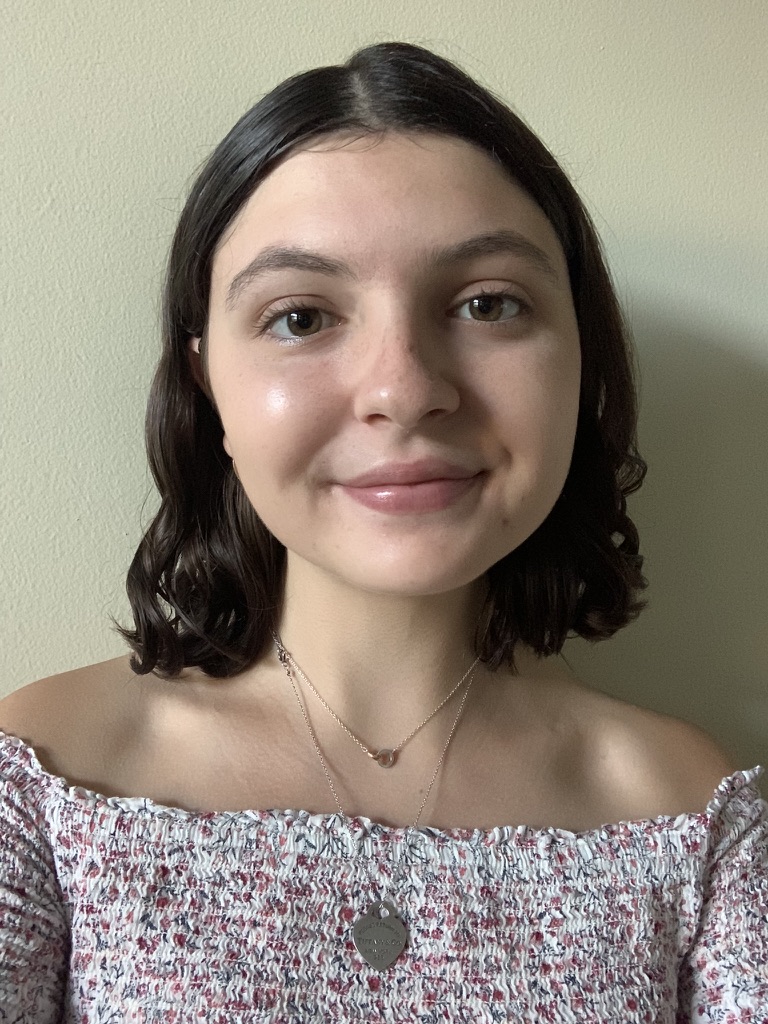
BIO
Hi, I'm Bailee Simmers, a freshman from Wellington, Florida, majoring in Physics and Astrophysics. I find the world of physics fascinating, and my research experience has only reinforced this passion. While my poster focuses on particle physics, my primary interest lies in exoplanetary research. After earning my undergraduate degree, I plan to pursue graduate studies with the goal of working in the space industry. Outside of research, I am involved in the Women in Physics & Astrophysics Association at FSU. In my free time, I enjoy exploring coffee shops, re-reading/re-watching Harry Potter, & rollerblading.
Identifying reactions in ?p→?-?+?0p
Authors: Bailee Simmers, Dr. Edmundo BarrigaStudent Major: Physics & Astrophysics
Mentor: Dr. Edmundo Barriga
Mentor's Department: Physics Mentor's College: Florida State University Co-Presenters:
Abstract
GlueX is a particle physics experiment located in Hall D at Thomas Jefferson National Accelerator Facility in Newport News, Virginia. GlueX started collecting data in 2017 and it is currently gathering more. The experiment's primary goal is to search for hybrid mesons, while also trying to get a better understanding of the light meson spectrum. GlueX allows the reconstruction of exclusive final states. When a reaction is produced, the GlueX detector must be able to measure and then identify the created particles. Once the final state particles are identified, they can be further analyzed. This allows us to identify the intermediate states from which these particles come from. The goal of my project is to analyze a portion of the data produced by the GlueX experiment. The data sample consists of the final state ?-?+?0p. Throughout the project, we distinguish different intermediate states present in the data, specifically ?. We study these particles by selecting them or removing them from the sample. We analyze the effects of the cut and selection by looking at mass distribution and correlation plots. We describe the effects of the cut/selection by extracting the ? yield from the sample.
Keywords: Physics, Particle Physics, Hadronic Physics
25th annual Undergraduate Research Symposium, April 1, 2025
Lila Rush Poster Session 2: 10:45 am - 11:45 am/ Poster #185

BIO
Lila Rush is a senior Literature, Media, and Culture major. Her research interests include critical theory, continental philosophy, and cultural studies. In 2024, she won the Cody Harris Allen Award for Outstanding Undergraduate Writing for an original research project on the Victorian poet A.A. Procter. Her honors thesis engages queer theory and psychoanalysis to theorize the femme lesbian subject in Virginia Woolf’s 1928 novel, Orlando. She is a teacher at the Alliance Française de Tallahassee and a DJ at WVFS Tallahassee 89.7FM. Upon graduation, she is relocating to Europe to teach.
Oblivion: Theorizing The Abject-Sublime in David Lynch’s Mulholland Drive
Authors: Lila Rush, Dr. Christina Parker-FlynnStudent Major: English Literature, Media, and Culture
Mentor: Dr. Christina Parker-Flynn
Mentor's Department: The Department of English Mentor's College: The College of Arts & Sciences Co-Presenters:
Abstract
David Lynch’s 2001 Mulholland Drive has been variously described as infuriating, dazzling, unsettling, strange-- “compelling, but intentionally inscrutable” (McCarthy 2001). These two ideas-- compelling, inscrutable-- ought not to be separated by contrast, but connected through cause and effect: it is precisely because of its inscrutability that we are compelled to Mulholland Drive, drawn down to “the place where meaning collapses” (Kristeva 2). This place, according to the psychoanalyst Julia Kristeva, is the abject-- the wasteland that lies beyond the perimeters of cultural acceptability, the defilement, repugnance, and rot that “life withstands, hardly and with difficulty, on the part of death” (Kristeva 2). Even so, the inscription to Kristeva’s “Powers of Horror” alludes to the paradoxical lure of the abject: “no Beast is there without glimmer of infinity” (1). Like a glimmer of beauty in the eyes of a beast (or a Lynchian bum, as it were), the abject compels even as it repels; it is, as Kristeva puts it, “edged with the sublime” (12). The aim of this project, then, is to theorize this spiral of abjection and sublimity through Mulholland Drive. Drawing on Kristeva’s theory in the original French, the project uses the linguistic polyvalence of "oubli," or "oblivion," to analyze the shattering experience of the abject-sublime on a diegetic and spectatorial level. Through this optic of oblivion-- which can mean both forgetting and being forgotten, but also “obscurity, nothingness, void, death”-- the project peers down this “very mysterious road" (“Oblivion”; Lynch 2005).
Keywords: Film Theory, David Lynch, Julia Kristeva, Psychoanalysis, Horror, Critical Theory
25th annual Undergraduate Research Symposium, April 1, 2025
Kaia Clemente Poster Session 2: 10:45 am - 11:45 am/ Poster #168
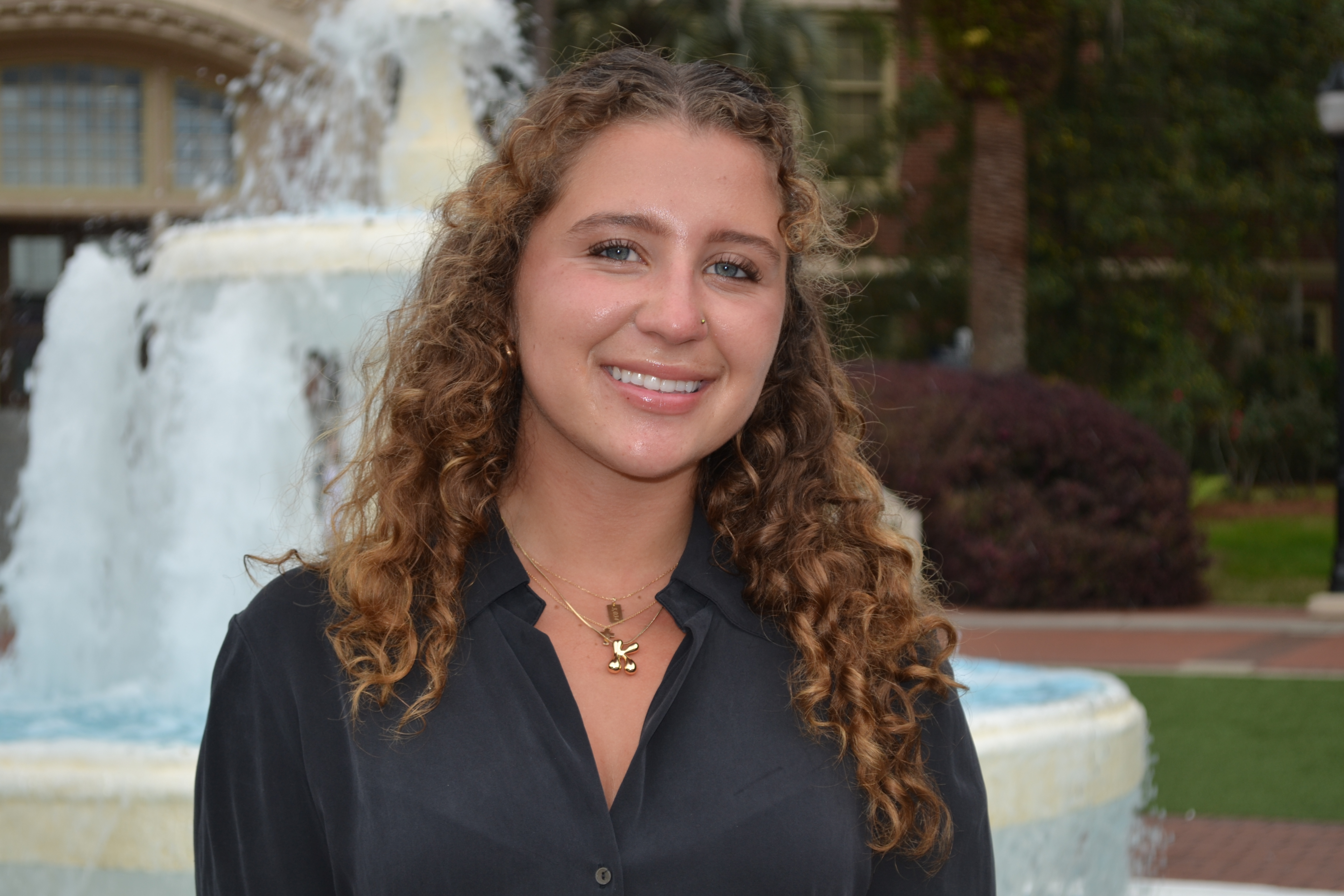
BIO
Hi! I'm Kaia Clemente and I'm a first year International Affairs major at FSU. I was born and raised in West Palm Beach, Florida and it's my favorite place in the world. I'm interested in history, culture, and architectural preservation of historic places. During my free time, I enjoy going to the beach, mountain biking, sailing, and spending time with friends and family. Next semester, I plan on studying abroad at the FSU Florence campus.
Heads Will Roll: The Toppling of the Rapa Nui Statues
Authors: Kaia Clemente, Dr. Amy KowalStudent Major: International Affairs
Mentor: Dr. Amy Kowal
Mentor's Department: Anthropology Mentor's College: Florida State Co-Presenters:
Abstract
This research explores the various potential causes for the toppling of all moai heads on Rapa Nui (Easter Island) using different techniques and collaborating with indigenous population, as well as their role in modern Rapa Nui culture. This is important because there are still many gaps in the scholarship about moai and the modern Rapa Nui are sometimes completely disregarded in research. This project used modern literature on the toppling of the moai, the archeological features of the island, and the modern culture present there. Scientific journals, ethnographies, and grant proposals were used to gather information and create a museum exhibit outline, which will be presented in the future. The expected results will shed light on the cause of the topping (e.g. earthquake, iconoclasm), which will settle a centuries old debate. Future studies could further involve indigenous populations and illuminate more information about the moai. The current state of the indigenous community is also explored through the research. This research is significant because indigenous populations have been restricted from interacting with and preserving their own cultural monuments due to a legacy of colonialism.
Keywords: Polynesia, anthropology, culture
25th annual Undergraduate Research Symposium, April 1, 2025
Ria Shah Poster Session 4: 3:00 pm - 4:00 pm / Poster #264
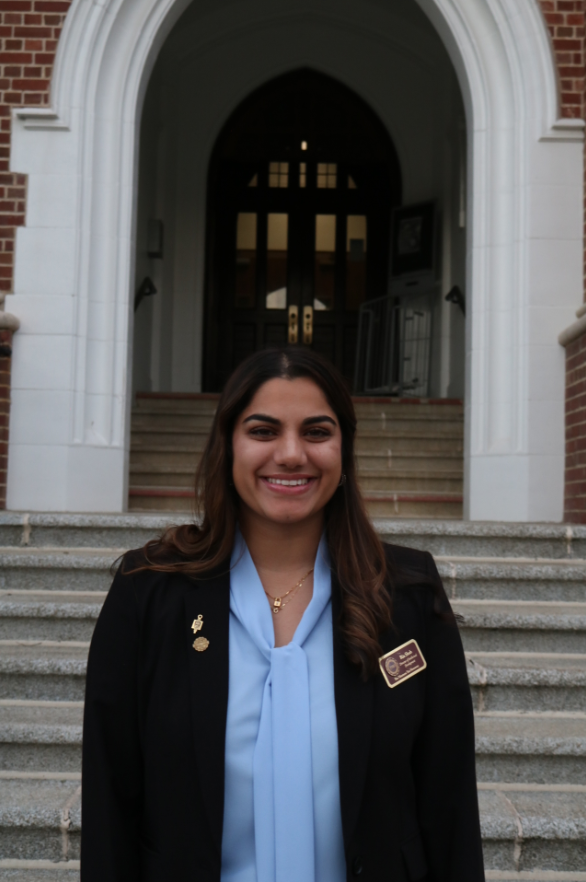
BIO
My name is Ria Shah, and I am from Orlando, FL. Currently a senior at Florida State University, I am pursuing a Bachelor of Science in Psychology with a minor in Child Development. From a young age, I became acutely aware of how cultural narratives can prevent individuals from seeking help and prioritizing their mental health. Witnessing these challenges across different communities sparked my passion for understanding human behavior through a psychological lens. My long-term goal is to pursue a Ph.D. with a focus on trauma and depression in vulnerable youth from underserved communities, utilizing biopsychosocial approaches. As a research assistant in the Motivated Social Cognition Lab, I have had the opportunity to explore topics related to gender and racial stereotypes, impression formation, and spontaneous trait inferences (STIs). These experiences have inspired me to create a more inclusive and compassionate environment surrounding mental health. In addition to my academic pursuits, I serve as a mentor in the Psi Chi Honor Society and contribute as an author and committee member for IfYou'reReadingThis (IYRT).
Exploring the Suppression of Intellectual Humility in Honor Cultures
Authors: Ria Shah, Dr. Irmak Olcaysoy OktenStudent Major: Psychology
Mentor: Dr. Irmak Olcaysoy Okten
Mentor's Department: Social Psychology Mentor's College: College of Arts & Science Co-Presenters:
Abstract
Intellectual humility (IH), the ability to recognize one’s knowledge limits and remain open to new information, is essential for critical thinking and decision-making. In honor cultures, where reputation and social standing are prioritized, individuals may be more defensive and less receptive to feedback, specifically when faced with criticism or failure. Fear of failure and insecurity can exacerbate this defensiveness, reducing IH by triggering identity-protective responses. This study examines the impact of cultural values on IH and explores the role of insecurity in this process. We investigate how fear of failure and insecurity influence IH in individuals from honor cultures. Participants were randomly assigned to a critical (failure) or control condition, with emotional impact measured by state anxiety and fear of negative evaluation. We hypothesize that individuals with high honor values will experience a significant decrease in IH when exposed to failure-induced insecurity. Additionally, we predict that insecurity will mediate the relationship between cultural background and IH. Results suggest a significant decrease in IH following the critical condition, with a negative correlation between anxiety and IH. These findings emphasize the intricate relationship between culture, insecurity, and intellectual openness, suggesting the need for interventions to foster IH in vulnerable contexts, such as self-affirmation techniques.
Keywords: Intellectual Humility, Insecurity, Honor Cultures
25th annual Undergraduate Research Symposium, April 1, 2025
Kyla Ahlstrom Poster Session 4: 3:00 pm - 4:00 pm/ Poster #8

BIO
I am a first-year student at Florida State University studying pre-nursing. I am originally from Prior Lake, Minnesota, but I have always loved Florida. I am interested in participating in medical-related research as well as volunteer work in health settings. My career goals consist of going to graduate school to study anesthesia and becoming a nurse anesthetist.
The Role of Information Communication Technologies in Mitigating Age-Related Cognitive Decline
Authors: Kyla Ahlstrom, Dorota Kossowska-KuhnStudent Major: NFA-Nursing
Mentor: Dorota Kossowska-Kuhn
Mentor's Department: Psychology Mentor's College: Florida State University Co-Presenters: Dinuki Wickramanayake
Abstract
With the increasing use of technology, it is important to identify how information and communication technology (ICT) can help mitigate cognitive decline with age. Experimental studies are essential for evaluating the impact of different types of ICT on cognition. ICT use can potentially help older adults learn new skills, maintain relationships, access information, and ultimately enrich their quality of life. Using the Covidence platform, we began a metanalysis by screening 3,516 scholarly interventional studies based on predefined inclusion and exclusion criteria. Following the initial screening, we proceeded to the full text review and data extraction stages. To ensure the reliability of our findings, two reviewers independently assessed the studies, with a third reviewer resolving any conflicts. We hypothesize that the use of ICT in experimental studies may not yield significant differences in cognition. The mechanisms by which ICT influences cognition remain unclear, but future studies analyzing longitudinal data could determine if ICT use has a lasting effect on cognitive function. If our analysis reveals a positive relationship between ICT use and cognition, it could suggest a promising role for technology in preventing cognitive decline and dementia in older adults.
Keywords: Cognition, Technology, Psychology
25th annual Undergraduate Research Symposium, April 1, 2025
Mariafe Concha Poster Session 3: 1:45 pm - 2:45 pm/ Poster #163

BIO
My name is Mariafe Concha and I'm a third-year Criminology major from Miami, Florida. Being a part of this research project has highlighted the complexities of law enforcement data and the importance of accurate legal frameworks, which has further fueled my passion for pursuing a career as a lawyer, with the intent to help those who are often marginalized or disadvantaged. I believe that studying the legal systems that protect both individuals and law enforcement will enable me to create meaningful change. Whether it’s defending human rights, ensuring fair treatment, or working to reform criminal justice policies, my passion is rooted in helping people and contributing to an equal, more just society. I am actively involved in Phi Alpha Delta Pre- Law Fraternity, the Peruvian Student Association, and the FSU Swim Club, all of which I am passionate about and deeply enjoy, as they allow me to connect with like minded individuals, explore my interests, and contribute to the community.
Understanding Assaults on the Police: A Systematic Review on the Strength, Limitations, and Future of National Data Sources for Empirical Research
Authors: Mariafe Concha, Keller SheppardStudent Major: Criminology
Mentor: Keller Sheppard
Mentor's Department: Criminology/ Law Enforcement Mentor's College: College of Criminology and Criminal Justice Co-Presenters: Kayla Berge, Kenneth Bevan III, Sydney Lindren, Krystine Mora-Becerra, Collin Paoli, Luisana Pereira, & Annette Rivera,
Abstract
Assaults on the police represent a pressing public policy issue, especially as law enforcement faces challenges in recruitment and retention due to the unique occupational dangers associated with policing. A growing body of empirical research has sought to understand the prevalence, risk factors, and consequences of these incidents; however, its development is complicated by the limitations of national data sources on police assaults. The aim of this systematic literature review is threefold: (1) assess the prevalence of each national data source on police assaults, (2) synthesize the limitations of these data sources as detailed in prior research, and (3) describe the unique feature of each data source that can facilitate future research. To this end, searches of literature published from January 1960 to September 2024 were performed using a combination of search strategies, such as electronic database searches, reference searches, and forward citation searches. Studies will be screened against a set of inclusion criteria and coded to address the study’s three key research questions. It is anticipated that the results of this study will highlight the key strengths and limitations of current national data on this crucial public policy issue. Further, it will illuminate opportunities to improve the state of police assault data and facilitate translational policing research.
Keywords: Assaults, Police, Systematic Review
25th annual Undergraduate Research Symposium, April 1, 2025
Isabella Ruiz Poster Session 2: 10:45 am - 11:45 am/ Poster #127
BIO
My name is Isabella Ruiz, and I am an economics major at Florida State University with aspirations for a career in law. My primary role in this research involved conducting literature reviews using academic databases and designing a research poster to present my research mentor’s findings. Through this process, I developed strong analytical and critical thinking skills, enhanced my ability to synthesize information, and gained experience in preparing research for publications and presentations, as well as effectively communicating research findings through both visual and written formats.
Does Hope in Cardiac Surgery Patients Improve Their Postoperative Symptoms?
Authors: Isabella Ruiz, Amy L AiStudent Major: Economics
Mentor: Amy L Ai
Mentor's Department: College of Social Work Mentor's College: College of Social Work Co-Presenters: Meghan Perez
Abstract
For middle-aged and older patients with heart conditions, anxiety and depression are significant comorbid mortality risks. Open heart surgery (OHS) is a life-changing procedure that can induce psychological distress, potentially hindering recovery in the postoperative period. Numerous studies highlight the positive health effects of optimism, a psychological trait associated with hope and resilience. Optimism has been linked to a lower mortality rate from cardiovascular disease, the leading cause of death in the United States. However, limited research has examined whether optimism mitigates the harmful impact of preoperative anxiety and depression on overall psychological distress following OHS. This multidisciplinary clinical study utilized a three-wave survey to evaluate a hypothetical model of these relationships in 311 U.S. patients before and one month after undergoing OHS. Structural equation modeling (SEM) was used to predict postoperative psychological distress. Optimism was measured using two subscales of the Life Orientation Test (LOT), while general psychological distress was assessed through the SCL-90 subscales for somatization, depression, and anxiety symptoms. The final model demonstrated a strong fit. Findings revealed that preoperative depression and anxiety had a more substantial negative effect on postoperative distress than optimism had in alleviating it. Additionally, female gender and older age were directly correlated with higher levels of postoperative distress. These results confirm the protective role of optimism in reducing the adverse psychological effects of poor mental health on heart patients. Health professionals should focus on strengthening patients’ inner resilience to promote better mental health outcomes during recovery.
Keywords: Psychological distress, Optimism, Literature review.
25th annual Undergraduate Research Symposium, April 1, 2025
Kylee Worth Poster Session 2: 10:45 am - 11:45 am/ Poster #176

BIO
Kylee Worth is a first year duel degree student in Theatre and Political Science from Sarasota, Florida. She is passionate about the arts and is planning to pursue a career in Entertainment Law. She is grateful for this opportunity to work on a research project that is vital to the preservation of arts within the community.
The Black Artist’s Way
Authors: Kylee Worth, Dee SelmoreStudent Major: Theatre and Political Science
Mentor: Dee Selmore
Mentor's Department: School of Theatre Mentor's College: College of Fine Arts Co-Presenters: Derionna Blidgen
Abstract
While theatre has been in practice since Ancient Greece, there has been little research about the psychological effects of portraying certain traumatic roles on actors. This is especially applicable to black actors, whose experiences were not taken into consideration by performance theorists such as Richard Schechner, the first theorist to begin recognizing a need for the implementation of de-roling techniques in the rehearsal space. Thus, leaving black actors vulnerable to negative impacts like boundary-blurring and vicarious trauma. De-roling is a set of processes actors use to disengage from the character they are portraying and return to themselves. Through working with actors and conducting research, a method of de-roling can be implemented into rehearsal practices to prevent such negative impacts. While there have been strides made to aid actors in separating themselves from traumatic roles in which method acting has taken place, these efforts neglect to recognize racial differences. Finding de-roling techniques tailored to black actors is imperative to creating a safe environment for black actors to engage with their characters without sacrificing their own identity in the process. While acting in August Wilson’s Fences, participants were given curated de-roling techniques that they used throughout the play's production. Participants were then interviewed on their experience using the de-roling techniques and surveyed on how often their character seemed to resurface after the production end. Although the data is still being analyzed, the results are expected to suggest that the curated de-roling techniques improved the participant's experience when disengaging from their character.
Keywords: Theatre, Arts, Culture, Art opportunities
25th annual Undergraduate Research Symposium, April 1, 2025
Mia Harrell Poster Session 4: 3:00 pm - 4:00 pm/ Poster #217
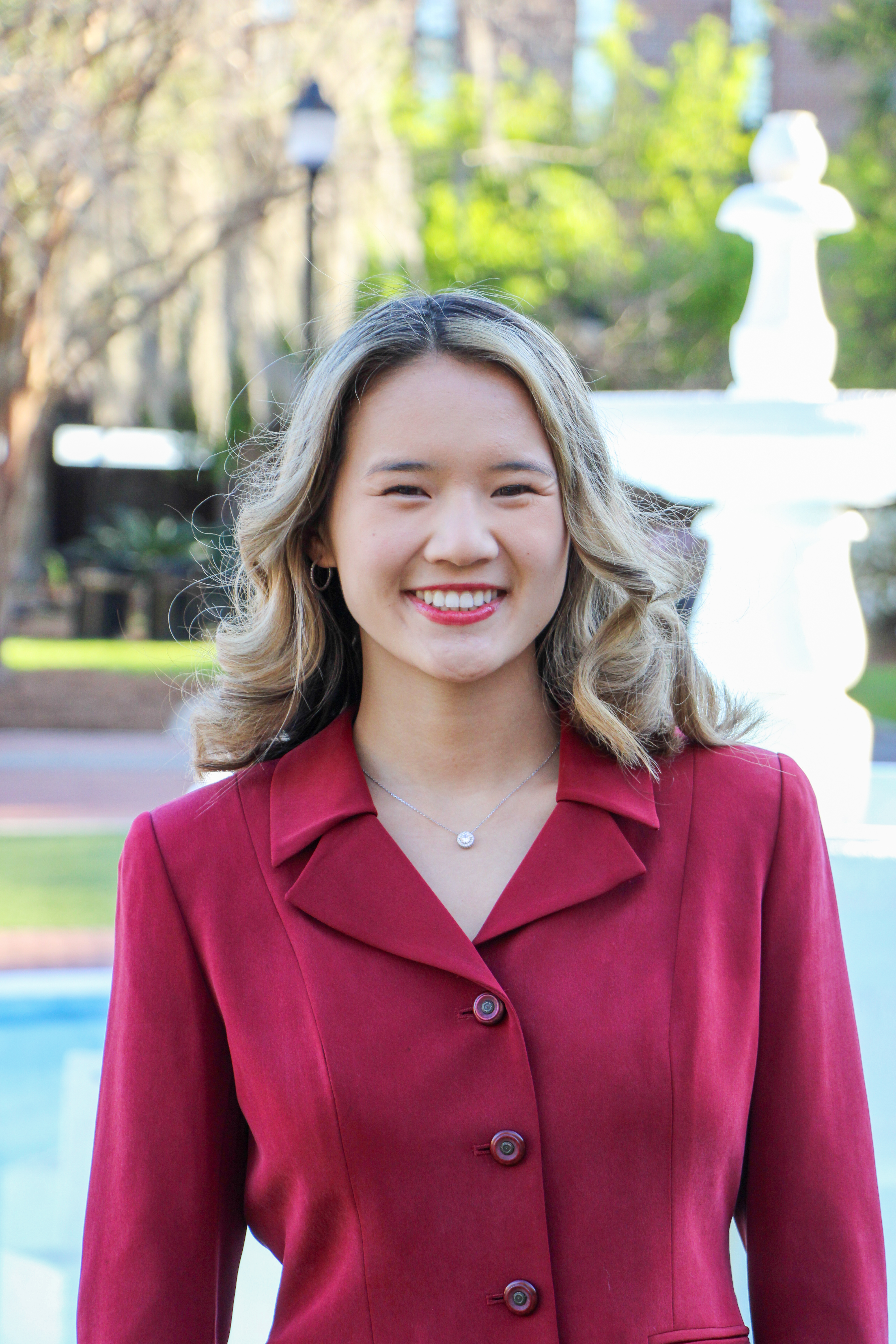
BIO
Mia Harrell is a first-generation college student from Sebastian, FL with a deep commitment to increasing inclusivity in healthcare. Driven by her innate curiosity, affinity for science, and passion for patient-centered care, Mia aspires to serve rural communities and individuals with exceptional abilities, particularly those with Down syndrome and neurodivergence.
Her interest in research began in high school, where she earned her BACE certification through a biotechnology program, equipping her with foundational laboratory skills. She has since expanded her expertise through her work in Jordan Lab, drawn to its innovative approach to medicine. This research, focused on developing non-invasive and highly specific treatments, aligned with her goal to address critical health disparities.
With obesity affecting over 40% of adults in the United States and contributing to life-threatening conditions such as heart disease and diabetes, Mia recognizes the urgency of advancing targeted medical interventions. Her work in the lab represents a step toward more effective, patient-tailored solutions, reinforcing her commitment to bridging the gap between scientific discovery and equitable healthcare access.
Ultimately, she aims to integrate research and clinical practice to create a more inclusive and effective healthcare system for all.
Post-transcriptional regulation of hepatic lipid metabolism by Y-box binding protein 1
Authors: Mia Harrell, Dr. James JordanStudent Major: Interdisciplinary Medical Sciences: Clinical Professions
Mentor: Dr. James Jordan
Mentor's Department: Biological Science Mentor's College: Arts and Sciences Co-Presenters: Jack Zhao, Rebekah Winborn, Paulos Samuels
Abstract
Metabolic dysfunction‐associated steatotic liver disease (MASLD) is a growing global health challenge characterized by excessive hepatic lipid accumulation in the setting of obesity and insulin resistance. Current therapies remain limited, underscoring the need to identify molecular drivers of disease progression. Y‐box binding protein-1 (Ybx1) is a single‐stranded nucleic acid binding protein implicated in MASLD in diet‐induced obesity (Jordan et al., bioRxiv, 2024), yet its role in hepatic lipid metabolism remains unclear. We performed an integrated multi‐omic analysis and identified ten genes bound by Ybx1 that displayed altered mRNA and protein expression. We hypothesized that these genes contribute to lipid accumulation in hepatocytes. To test this, we knocked down eight of these genes in hepatocyte‐like Huh7 cells using siRNA. Cells were then exposed to 0.25 mM oleic and palmitic acid for 16 hours to mimic a high‐fat diet, stained with Oil Red O, and analyzed using ImageJ. Lipid content was quantified by extracting Oil Red O from intracellular droplets and measuring absorbance at 492 nm. Preliminary results indicate that among seven genes with transcripts stabilized by Ybx1, siRNA against three—Carnitine O-Acetyltransferase (CRAT), Vanin 1 (Vnn1), and Abhydrolase domain containing 2 (Abhd2)—reduced lipid accumulation. In contrast, knockdown of Carboxylesterase 3 (Ces3), a gene negatively regulated by Ybx1, increased lipid storage. These findings reveal a dual regulatory role for Ybx1 in hepatic lipid metabolism and identify potential targets for MASLD therapy. Future work will validate these targets using overexpression, confirm Ybx1:mRNA interactions by ChIP‐qPCR, and test Ybx1’s role in mRNA stability with RT-qPCR.
Keywords: Liver, Obesity, Epigenetics, Nutrition, RNA
25th annual Undergraduate Research Symposium, April 1, 2025
Scarlett Conquest Poster Session 2: 10:45 am - 11:45 am/ Poster #1

BIO
Hello I am Scarlett Conquest and I am a second-year Political Science and English Literature major. I hail from the great state of California, but I've been living in Florida for the past five years. My research interests are politics, history, and literature. I hope to have a career in politics and government in the future.
Measuring Elite Sentiment on the Palestinian-Israeli Conflict
Authors: Scarlett Conquest, Hashim MalallahStudent Major: Political Science and English Literature
Mentor: Hashim Malallah
Mentor's Department: Political Science Mentor's College: Social Science and Public Policy Co-Presenters: James Banks
Abstract
In 1947 the United Nations Special Committee on Palestine proposed a plan for the partition of Mandatory Palestine, in which two states would be created, an Arab state and a Jewish state. While this plan was accepted by the Jewish Agency for Palestine, the Zionist organization interested in the creation of a Jewish state, the Arab League, representing Arab interests in the region, rejected it. The plan was adopted by the Special Committee but was never implemented as mounting tensions between Jewish and Arab inhabitants of Palestine led to a civil war. Zionist forces were able to secure independence in 1948, displacing millions of Palestinians in the process. The civil war saw many tragedies on both sides, however the Nakba, the ethnic cleansing of Palestinians by Zionist forces, remains one of the most prominent episodes in history. The total number of casualties suffered by the Palestinians is not known but it is estimated in the thousands. As events unfolded in Palestine, the United Nations General Assembly produced hundreds of resolutions on the question of Palestine, in attempts to manage the humanitarian crises produced from mass displacements and the presence of occupying forces while also demanding the cessation of violence on both sides. It is from these resolutions that we as researchers can study what elites think of the conflict between Israel and Palestine and how such sentiment shapes foreign policy.
Keywords: United Nations, Israel, Palestine
25th annual Undergraduate Research Symposium, April 1, 2025
Sia Kakkar Poster Session 2: 10:45 am - 11:45 am/ Poster #249
BIO
I am from Orlando, and my love for neuroscience, psychology, and mental health advocacy drives everything I do. My research interests focus on neurobehavioral function, trauma recovery, and the cognitive effects of eating disorders.
Beyond academics, I stay active through tennis and running, which fuel my curiosity about the mind-body connection. My family is my greatest support system, and their encouragement has shaped my passion for helping others. I am also deeply passionate about animals and have dedicated time to volunteering at shelters. One of my long-term dreams is to start my own animal shelter once I have the resources to create a safe haven for animals in need.
As a mental health advocate, I aim to connect neuroscience and psychology to improve patient outcomes. My goal is to pursue medical school and contribute to advancements in psychiatry or neuroscience while continuing to support mental health awareness, research, and community initiatives.
SMART-NF1: Daily Neurobehavioral Function and Psychosocial/Lifestyle Predictors in Adolescents with NF1
Authors: Sia Kakkar, Yang HouStudent Major: Computational Biology
Mentor: Yang Hou
Mentor's Department: Behavioral Sciences and Social Medicine Mentor's College: College of Medicine Co-Presenters:
Abstract
Neurofibromatosis Type 1 (NF1) is a genetic disorder associated with cognitive, behavioral, and socioemotional difficulties, yet research on how these challenges affect daily neurobehavioral functioning remains limited. This study examines these functions in adolescents (ages 13–17) with NF1 using ecological momentary assessment (EMA) to collect real-time data on behavior, mood, and cognition. We hypothesize that parenting style, social support, coping strategies, physical activity, and sleep quality will significantly influence cognitive and socioemotional functioning. Participants will complete online surveys, daily assessments via a smartphone app, and wear a Fitbit activity tracker for two weeks.
As a research assistant, my role includes data collection, participant communication, and survey administration. We expect findings to show that higher social support, increased physical activity, and better sleep quality correlate with improved cognitive and socioemotional outcomes.
A key strength of this study is its real-time data collection, reducing recall bias and providing a more accurate picture of daily challenges. However, limitations include self-report bias, limited generalizability due to sample size, and potential noncompliance with daily assessments. Findings will contribute to a deeper understanding of NF1-related challenges and inform targeted interventions to improve adolescent well-being.
Keywords: **Keywords:** Neurofibromatosis Type 1, Neurobehavioral Functioning, Ecological Momentary Assessment
25th annual Undergraduate Research Symposium, April 1, 2025
Luis Sanchez Poster Session 3: 1:45 pm - 2:45 pm/ Poster #127
BIO
I am an undergraduate researcher at Florida State University's eHealth Lab, my focus has been on leveraging natural language processing (NLP) and annotation tools to improve healthcare decision-making. I came across UROP and the E-health lab because of my interest in the intersection of data science and healthcare, exploring ways to enhance medical information accuracy and patient outcomes through advanced data analysis techniques. My research involved annotating social determinants of health data and optimizing NLP and tuning parameters for predictive accuracy.
Annotation and Information Extraction of Social Determinants of Health from Social Worker Notes of Pediatric Transplantation
Authors: Luis Sanchez, Zhe HeStudent Major: Statistics and Information Technology
Mentor: Zhe He
Mentor's Department: School of Information Mentor's College: FSU College of Communication and Information Co-Presenters: Harjith Pradeep
Abstract
Electronic health records (EHRs) are widely used in developing machine learning models for health outcome predictions. However, these models often exhibit inherent biases due to the omission of crucial risk factors related to social determinants of health (SDoH), which contribute to up to 40% of preventable deaths.
This UROP project aims to establish a rigorous annotation guideline for SDoH-related factors and train transformer-based models to recognize these labels.
The first phase of the project focuses on creating a precise annotation framework to ensure high-quality training data. To achieve this, we collaborated with domain experts in social work and consulted a highly qualified annotator from the University of Florida (UF). Based on these insights, we developed a comprehensive annotation guideline, which will be publicly available in the future. The annotation process consists of two levels: the first level identifies the trigger words corresponding to each SDoH category, while the second level provides more detailed contextual information related to those triggers.
In the second phase, we train transformer-based models to extract trigger words from EHRs. Given the complexity of our multi-label annotation framework, model training presents significant challenges. To address this, we benchmark various BERT-based models to identify the most effective one. Once the trigger words are extracted, the corresponding sentences are fed into large language models (LLMs) to further analyze and extract deeper contextual information.
This project not only enhances SDoH annotation quality but also contributes to improving bias-aware predictive modeling in healthcare.
Keywords: Annotation Tags Natural Language Processing Heart Transplant Social Determinants Artificial Intelligence


